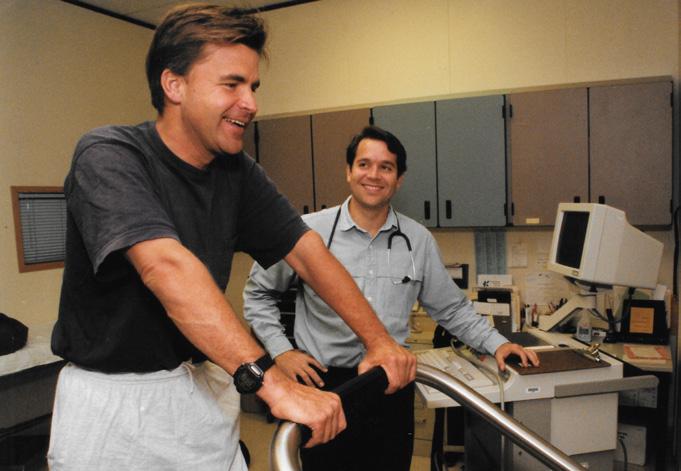
Arcadia Jets Makes Industry Impact with Integrity, Innovation, and Philanthropy.

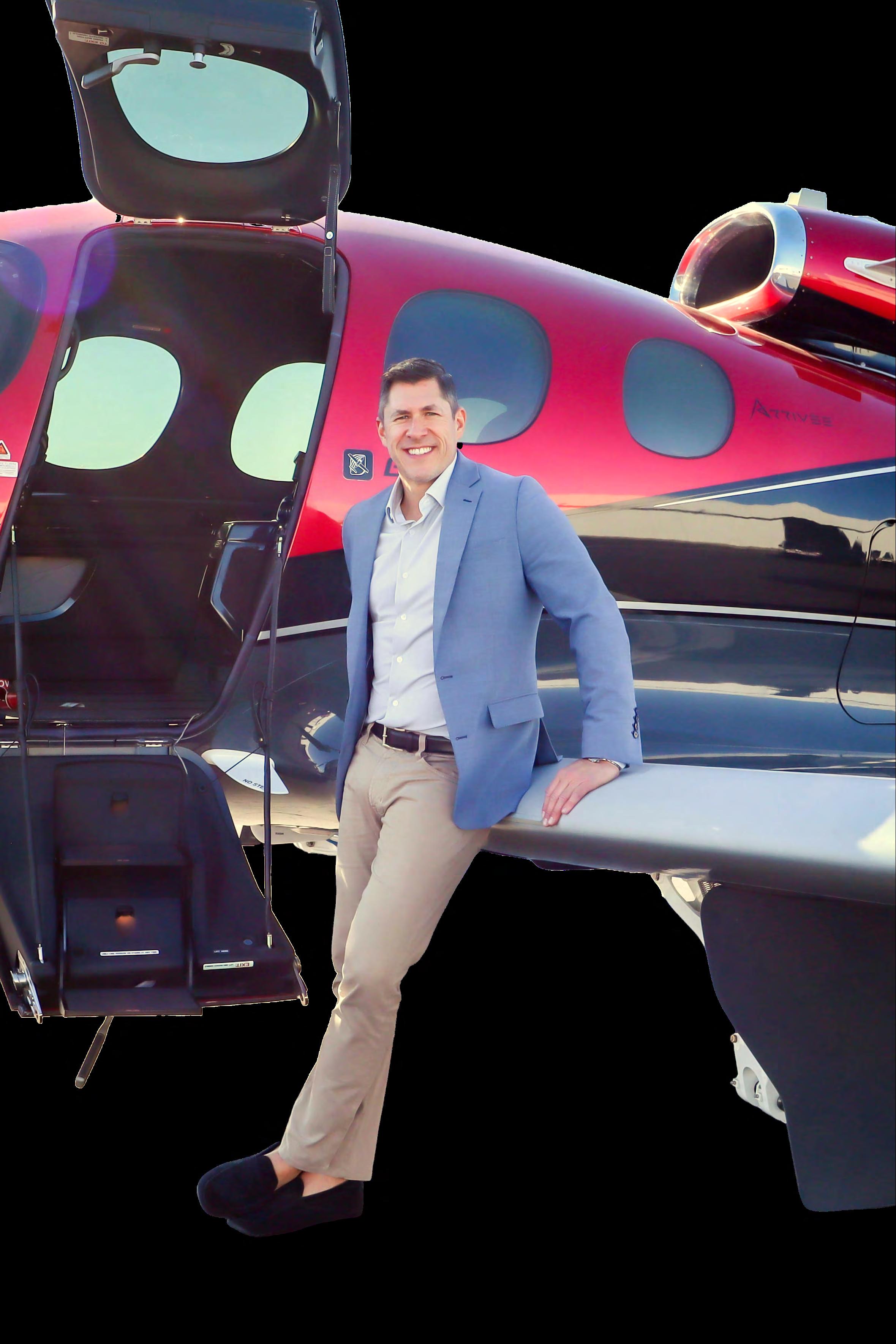






Arcadia Jets Makes Industry Impact with Integrity, Innovation, and Philanthropy.






To list your group’s event on a space available basis, please send your event notice with date, time, place w/city and state, contact name, and phone number to: Calendar, In Flight USA, P.O. Box 5402, San Mateo, Calif. 94402, or email vickie@inflightusa.com.
Note: Calendar includes only information available by our press date. Confirm the status before attending.
Nov. 1: Hangar Talk and Flight of the Grumman F6F Hellcat and Grumman F7F Tigercat, Planes of Fame Museum, Chino, CA, planesoffame.org
1: Compton Airport Air Fair, Compton, CA, interractive exhibits, historic aircraft, hands-on STEM activities
2: Glider Discovery Day, Hiller Aviation Museum, San Carlos, CA, hiller.org
1-2: Florida International Air Show Punta Gorda, FL, U.S. Navy Blue Angels, F-16 Viper Demo Team, floridaairshow. com
1-2: Thunder Over the Sound: Keesler/ Biloxi Air & Space Show Keesler AFB, Biloxi MS, MS U.S. Air Force Thunderbirds, thunderoverthesound.com
1-2: Texas Over the Capital Airshow, San Maros, TX, F-22 Raptor Demonstration Team, F/A-18 Super Hornet W Legacy Flight, U.S. Navy Rhino Demonstration Team East, Adam Baker Airshows, Airshow Announcer Brittany, Commemorative Air Force, Herb Gillen Airshows, Jim Tobul Airshows, Navy Legacy Flight, Northern Stars Aeroteam, U.S. Air Force Heritage Flight Foundation, texascapitalairshow.com
6: Affordable Flying Expo 2025, Lakeland, FL, Pure Sport Aviation, affordableflying.net
6: Hangar Talk at Planes of Fame Museum, Chino, CA, Flight of the Lockheed P-38J Lightning, Junior Aviator’s Day, and the Santa Claus Fly-In! planesoffame.org
7-8: US Aircraft Expo Scottsdale, AZ, Scottsdale, Az, usaircraftexpo.com/ scottsdale2025/
7-8: Blue Angels Homecoming Air Show, NAS Pensacola, FL, naspensacolaairshow.org
7-9: Stuart Airshow, Stuart, FL F-35A Lightning, Demonstration Team, U.S. Air Force Heritage Flight Foundation, stuartairshow.com
8: Palm Springs Air Museum 29th Birthday / Veterans Day Air Fair, Palm Springs, CA, palmspringsairmuseum.org
8: Salute to Service: Dine and Dance, Aerospace Museum of California, McClellan Park, CA, www.aerospaceca.org
8: EAA Chapter 96 Build and Fly Special Session, Compton, CA, intensive RC model building and flying initiative
9: Air Power Adventure Hiller Air Museum, San Carlos, CA, hiller.org
11: Veterans Open Cockpit Day, Aerospace Museum of California, McClellan Park, CA, www.aerospaceca.org
15: Crystal Eagle Award & Scholarship Awards Dinner, San Carlos, aeroclubnocal.org
21-23: Acupulco Airshow, Acapulco, MX, Aarron Deliu, Brad Wursten Airshows, Go EZ Aerobatics, Melissa Dawn Burns, Racers Jet Team, The Pink Jet, Undaunted Airshows
22: Props and Hops, Palm Springs Air Museum, Palm Springs, CA, palmspringsairmuseum.org
26: Helicopter Turkey Toss & Turkey Hunt, Hiller Aviation Museum, San Carlos, CA, hiller.org
28: Starlight Nights, Hiller Aviation Museum, San Carlos, CA, hiller.org
Dec. 1-31: Snoopy and the Red Baron, Aerospace Museum of California, McClellan Park, CA
5-6: Vintage Weekend Ocean Reef Air Show, Key Largo, FL, AnnouncerSolution.com, Commemorative Air Force, Doug Litton Airshows
5: Castle Air Museum Tree Lighting Ceremony, Atwater, CA
6: For Love of Country Gala, Pearl Harbor Hangar 79, Honolulu, HI, pearlharboraviationmuseum
7: Air Power Adventure Hiller Air Museum, San Carlos, CA, hiller.org
7-9: Stuart Air Show, Stuart, FL, F-35A Demo Team, Titan Aerobatic Team, Northern Stars Aeroteam, Younkin Airshows, RJ Gritter, Ghostwriter Airshows Ft. Nathan Hammond, stuartairshow.com
13: Pappy Boyington & The Black Sheep, Palm Springs, CA, palmspringsairmuseum.org
14: Crystal Eagle Award & Scholarship awards Dinner, Lakewood, CA, Facebook @ EaaChapter96.
19-22: Snowtopia, Palm Springs, CA, palmspringsairmuseum.org
26: Starlight Nights, Hiller Aviation Museum, San Carlos, CA, hiller.org



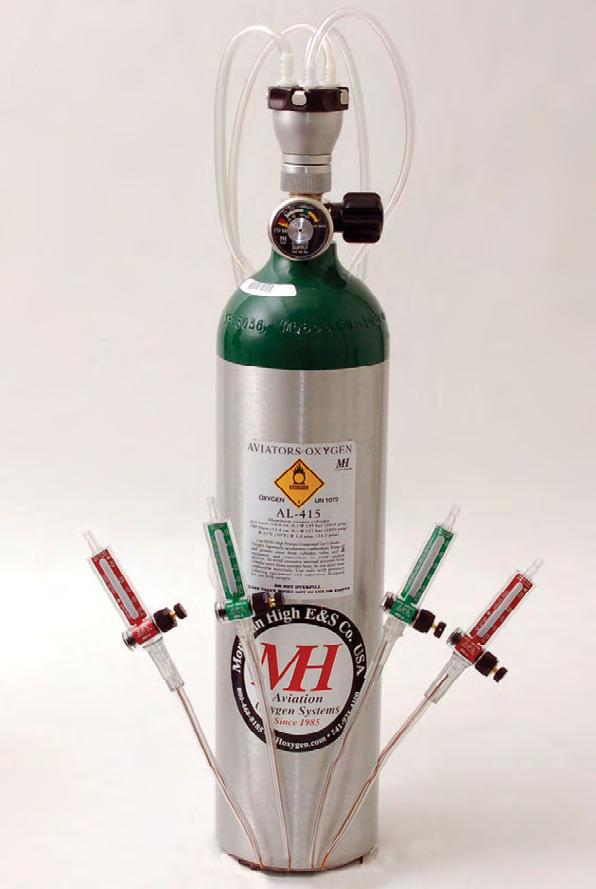

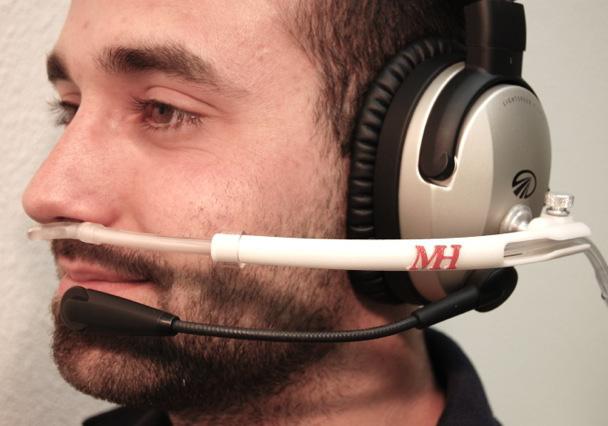
A new name is taking flight in the world of aircraft sales and acquisitions.
Arcadia Jets, headquartered in Phoenix, Arizona, officially launched in January 2025 with a bold mission: to make an immediate, positive impact on the business aviation industry through a combination of integrity, innovation, and giving back.
Founder Adam Hahn, with more than 20 years of experience in aircraft brokerage and acquisitions, Arcadia Jets was built on a simple but powerful philosophy — put the client first and do business differently.
Doing Things Differently
From day one, Arcadia Jets set out to stand apart from traditional brokerage firms. Every transaction is handled with transparency, data-driven market analysis, and a focus on long-term re-
lationships rather than one-time deals.
“We wanted to create a company that clients could truly trust,” said Hahn, CEO/Founder of Arcadia Jets. “Our goal is to combine expert market knowledge with genuine, personal service — ensuring that each client feels valued and confident through every step of their aircraft transaction.”
Whether handling an acquisition, listing a client’s aircraft, or facilitating an off-market opportunity, Arcadia Jets tailors its strategy to each client’s unique needs and goals.
A Commitment to Giving Back
Arcadia Jets believes that aviation can be a force for good — both in business and in the community. To reflect that, the company pledged that for every aircraft sold, whether through a

client acquisition, sale, or off-market transaction, a donation will be made to Angel Flight West.
Angel Flight West is a nonprofit organization that arranges free, non-emergency air transportation for people facing medical and humanitarian needs throughout the western United States.
“We built philanthropy into our business model from the beginning,” Leslie Mogensen, Director of Business Development continued. “Our partnership with Angel Flight West ensures that every deal we complete also helps someone in need. It’s our way of giving back through the gift of flight.”
Rapid Growth and Expansion
In its first year, Arcadia Jets has already begun expanding its team and capabilities. The company recently wel-
comed Hunter Yahya, an experienced Director of Aircraft Market Research, a role dedicated to gathering market data and providing analysis and intelligence using advanced data tools and proprietary systems to bring clients the most up to date information and data to ensure they are making the best possible decision for their mission.
Additionally, three new aircraft sales professionals will be joining the company, strengthening its presence in key markets and ensuring that clients continue to receive top-tier service and attention.
Arcadia Jets is proud to bring together a team whose collective expertise spans every corner of the aviation market. Their newest members contrib-
Continued on Page 9
























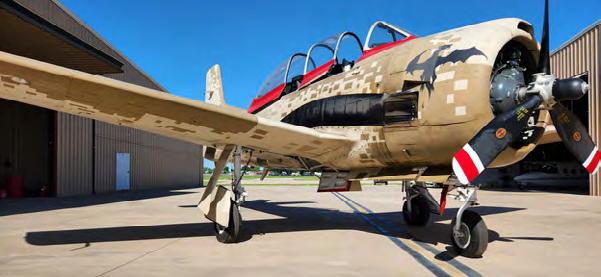
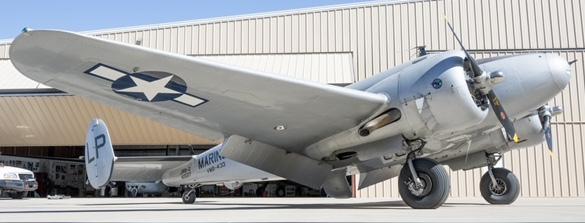




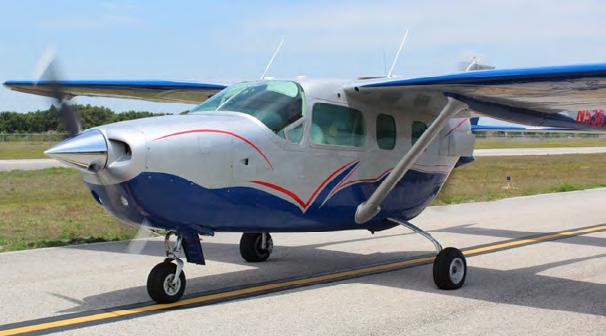
It is an empty feeling. While training at a local Class G airport in a well-equipped (for the day!) Cheroke 235 with a full stack of King radios (1970’s vintage!), it seemed as though the world had gone silent. While shooting touch and goes with the student/ owner, we were dutifully making CTAF calls with the expectation that all interested parties were hearing our calls. Another plane entered the pattern, and I called that specific aircraft on CTAF to coordinate our activities, only to receive silence. Quickly confirming the correct frequency, I tried again… no results. We had been picking up previous CTAF calls, but all was now silent. Is anybody out there?
polite, the controlled advised that Kansas City Center had picked up our 7600 squeak, assessed that we were headed for our home field and had contacted the tower with our position and apparent pattern entry plan. Then, surprisingly, the controller apologized for not giving us a green light. The light gun was inoperative, and budget had not been allocated to replace it… perhaps a precursor of what we are experiencing today, an ATC system that is not well funded or managed. It all ended well, with me filing a NASA ASR report and having no further contact from the FAA.

Publisher/Editor
Managing Editor .............................................................Annamarie Buonocore
Production Editors ...................................................Matt DuBois, Steve Pastis
Associate Editors...... Paul T. Glessner, Nicholas A. Veronico, Sagar Pathak
Staff Contributors ..............S. Mark Rhodes, Larry Nazimek, Lea Buonocore
Columnists...Eric McCarthy, Ed Wischmeyer, Denise DeGregoire, Ed Downs
In Flight USA is published each month by In Flight Publishing. It is circulated throughout the continental United States. Business matters, advertising and editorial concerns should be addressed to In Flight USA, P.O. Box 5402, San Mateo, Calif. 94402 or by calling (650) 358-9908–fax (650) 358-9254. Copyright © 2008 In Flight Publishing.
In Flight USA is not responsible for any action taken by any person as a result of reading any part of any issue. The pieces are written for information, entertainment and suggestion – not recommendation. The pursuit of flight or any action reflected by this paper is the responsibility of the individual and not of this paper, its staff or contributors. Opinions expressed are those of the individual author, and not necessarily those of In Flight USA
All editorial and advertising matter in this edition is copyrighted. Reproduction in any way is strictly prohibited without written permission of the publisher.
In Flight USA is not liable or in any way responsible for the condition or airworthiness of any aircraft advertised for sale in any edition. By law the airworthiness of any aircraft sold is the responsiblity of the seller and buyer.
My student and I checked headset connections and tried the number two radio… no luck. Apparently we had experienced a classic comm failure. Being VFR, we could just land at the Class G airport we were now utilizing, but this would leave us about 40 miles from our home base (and cars). Our home airport was a busy Class D field with a chaotic traffic pattern populated by students from a large university pilot training program. Returning to our home airport for a no-radio approach and landing was legal but landing and phone call would have improved safety. Regrettably, this Class G airport had no services on weekends, thus no phone. As “old guys” who were not brought up in the era of cell phones, it never occurred to us to employ this modern age “annoyance” for a purpose other than cutting off “robo-calls.”
Having experienced no change in weather or winds, it could be reasonably concluded that our home traffic pattern would not have changed, so the call was made to head for home. We set the ADS-B to 7600, planning for a classic 45-degree entry to the downwind at pattern altitude. With landing light on and several failed attempts to raise the tower, we observed the traffic (lots of it) and joined the pattern behind a college Cirrus, watching the tower for a steady green light… nothing. Did they see us? We followed the school Cirrus at a respectable distance and lined up on final approach… still no green light. We landed so as to make the first exit, (clearing the runway as soon as possible) leaving us with the challenge of crossing another active runway in order to reach the ramp and our hangar.
We were greeted by an airport “follow me” truck which escorted us to the ramp, solving the active runway crossing issue. Once shut down, I finally remembered my cell phone and called the tower to thank them for the service and to apologize for any problems we may have caused. Ever
A publication distributed monthly by NASA, “CALLBACK” summarizes aviation related “experiences” from every aspect of the aviation industry (learn more at ASRS - Aviation Safety Reporting System). Reports are received through the NASA Aviation Safety Reporting (ASR) system, the voluntary program this writer participated in following my no-radio landing. “CALLBACK” summarizes such events, often presenting only a part of an incident and then asking the question, “What would you have done?” Good question. After reading the preceding account, what would you have done? Was landing at a Class D airport without radio contact in violation of any FAR? Should the landing have been continued without a green light? Loss of comm in VFR conditions is not an emergency but it does require common sense and knowledge of the airport you have chosen. In this case, the Class D airport was very well known to this writer with the traffic pattern and preferred runway already established based upon a departure from that airport less that an hour before the comm loss. Would this writer have made the same decision at an unknown Class D airport in a busy metropolitan area… probably not. Should this writer have included his cell phone as an in-flight resource… you bet! I now have local tower center, TRACON and ARTCC phone numbers listed in my contacts list!
There are specific procedures for loss of comm in flying IFR. Basically, fly the last assigned or filed route, fly the last assigned altitude, expected altitude or MEA, which ever is higher and finally, leave a holding pattern at the expected further clearance time. All well and good, but in the real world (versus an answer in the IFR written exam), the first trick in determining if you have lost comm is simply realizing that you HAVE lost comm! In the experience just described, the comm radios were working just fine. The failure was in the audio pan-
Continued from Page 6
el, a common touch point for all nav and comm avionics. It took a trip to the avionics shop to figure that one out!
In another case of lost comm experience by this writer was in IMC conditions. Given over 65 years of pro and recreational flying experience, this writer has had numerous lost comm experiences, given equipment that does not have the reliability of today’s solid state marvels. Fortunately, most have been while in VMC weather, but a couple while IMC. Based strictly upon personal experience, and not official recommendations, allow an old pilot to share some thoughts.
• How about a stuck mike? Not necessarily yours, but somebody else’s stuck mike will kill a frequency. If talking of ARTCC or TRACON, switch back to the previous
frequency. If a tower, try ground control.
• Modern headsets do everything from providing wonderful, noise abated sound to making fresh coffee. But those options can get confusing, ending up with several volume options resulting in no sound. Is the jack plugged in? How about those “Blue Tooth” systems… are you up to the technology? Is your audio panel selected to “speaker” with the volume turned down?
• Do you have your headset isolated for others wearing headset systems, possibly talking over transmission you should be hearing?
• Of course, you have the correct frequency selected… right? We have a lot more digits to input than we did years ago, increasing the chance of error. Was the
Continued on Page 27






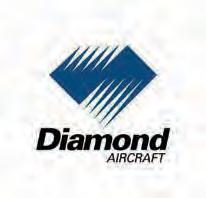








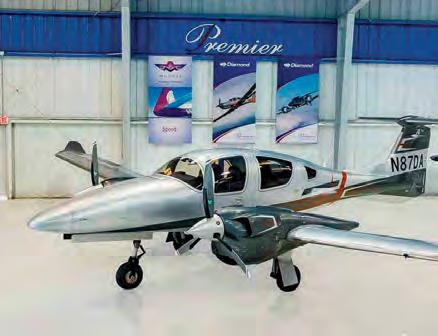


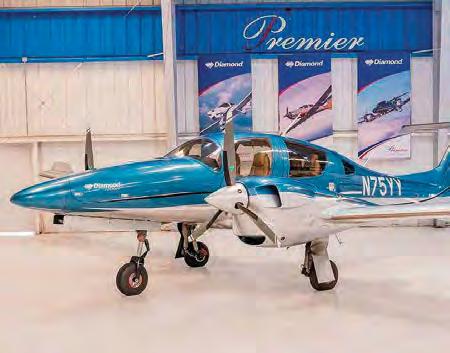



Continued from Page 4
ute a wealth of broad skills and knowledge, with backgrounds in aircraft operations, finance, sales, and technical support. This diverse experience means their clients benefit from a depth of insight and top-tier attention that ensures every transaction receives thorough, personalized backing from professionals who understand the industry inside and out.
By leveraging the full spectrum of their team’s capabilities, they’re able to approach each client’s needs with creativity and precision. Whether navigating complex acquisitions or finding unique market opportunities, Arcadia Jets’ commitment to a multifaceted approach ensures their clients get the very best service and support.
As part of its commitment to excellence and professional development, Arcadia Jets is proud to announce its membership in NAFA (National Aircraft Finance Association).
Becoming part of NAFA allows Arcadia Jets to connect with other leaders in the aviation finance and brokerage community, stay informed about emerging trends, and uphold the highest industry standards.
“NAFA membership represents our dedication to continuous growth and best practices,” said the Arcadia Jets team. “It connects us to a network of professionals who share our values of service, transparency, and innovation.”
With a growing team, a data-focused strategy, and a mission that blends business success with community impact, Arcadia Jets is positioning itself as a rising force in the aircraft sales and acquisitions market.
“We’re not just here to sell airplanes,” says Hahn. “We’re here to build relationships, elevate the client experience, and make a meaningful difference in the world of aviation.”
About Arcadia Jets
Founded in January 2025 and headquartered in Phoenix, Arizona, Arcadia Jets specializes in aircraft brokerage, acquisitions, and advisory services for discerning clients worldwide. The company combines decades of aviation experience with modern data analytics and a client-first approach. For every aircraft sold, Arcadia Jets donates to Angel Flight West, supporting charitable air missions that provide hope and access to those in need.
Learn more about Arcadia Jets at www.ArcadiaJets.com.
U.S. Transportation Secretary Sean P. Duffy recently announced that the Federal Aviation Administration (FAA) has deployed the first phase of a brand-new Notice to Airmen (NOTAM) service months ahead of schedule. The NOTAM service, which provides critical safety alerts about changes in the airspace, was originally built in 1985. It has experienced multiple outages in recent years, including a 2023 nationwide failure under the last administration. This important deployment milestone was achieved on-time and on-budget after Secretary Duffy accelerated the modernization effort.
“This is the promises-made, promises-kept administration. We are bringing
our aviation system into the 21st century at lightning speed to enhance safety in our skies. The new NOTAM system is an important proof point of how we can quickly and effectively modernize our skies under the leadership of President Trump,” said Duffy.
The new NOTAM Management Service (NMS) began operations on September 29, initially distributing NOTAMs to early adopter stakeholders. This initial deployment establishes the framework for the new service, enabling testing and validation with early user adopters. The full transition to the new single-source NOTAM service is on track for late Spring 2026.







































































No, this is not an invitation to swat our most common “bug buddy.” This writer is inviting our readers to join in as a “Fly on the Wall,” as a topic is discussed which mainly concerns an important subset of the aviation professional community: the Certified Flight Instructor (CFI). It is my hope that those “listening in” to the following thoughts, stories and conclusions may gain insights that are applicable to your next flight with family and friends. Allow the following to shed some light. This writer has been an active CFI for 65 years, teaching in airplanes that range from typical GA machines, experimental designs and antiques to the world’s largest airliners. I currently conduct Flight Instructor Refresher Courses and try to keep up with flight standards, technology and flight instructing trends. The current trend is that many CFIs in today’s system are young pilots, fresh out of a “learn to be an airline pilot school,” who are primarily flying as “time builders.” Safety statistics appear to have taken notice of the fallibility of CFIs, as a surprising number of accidents occur with a CFI on board. While it is recognized that flight instructing does carry a heightened risk factor, as much training involves flying in busy traffic patterns, distractions, edge of envelope maneuvers, and the reality of take-off and landing training, the FAA continues to highlight one particular area of concern… that being… who is flying the plane? Apparently, a disturbing number of CFI’s are not mentally engaged in every moment a training session is in progress, allowing circumstances or mistakes to get out in front of them. Possibly related to the “who is flying the plane” aspect of CFI involved accidents, a recent NTSB accident report caught this writer’s attention and brought back memories that might carry a lesson which will be of value to those reading this editorial.
loss of power. The NTSB report concluded that the left seat pilot (FBO and plane owner) was flying the airplane, as he made a quick radio call indicating a problem. At an altitude of just under 200 feet above field elevation, an abrupt, steep, turn was initiated back to the airport, resulting in loss of control and impact short of the runway. All who teach the “impossible turn,” (including this writer) and the experienced CFI on board the doomed plane, know that a return to field would not have been possible. So, why is there no evidence that the experienced CFI might have tried to take over the controls and maneuvered the plane into a controlled impact flying straight ahead with wings level and at minimum speed? One can only speculate. Was the CFI in a mindset of being a passenger, not the PIC? Did the CFI’s friendship with the FBO owner cause the CFI to hesitate, unconsciously not wanting to “insult” his friend? At this point readers are probably thinking, “Sure Ed, a typical Monday morning quarterback comment.” Frankly, I am inclined to agree with such thoughts when reading some accident analysis, ready to criticize those authoring the accident report. But there was an event very early in this writer’s flying career in which I was faced with a similar decision, with only seconds to spare before impact. Reading this NTSB report caused me to look back in time, wondering why I reacted as I did, resulting not only in avoiding a devastating outcome, but instilling a mindset that remains in my professional tool kit to this day. Join me for a trip back in time as we explore a phenomenon seldom discussed, the possibility that a CFI is, in some form, psychologically “intimidated” by the student (or PIC), thereby causing a fatal hesitation in a critical situation.




The accident in question involved an FBO owner, a high-time pilot, and noted instructor, a former member of a military demonstration team. They were departing a typical GA Airport in single-engine GA plane, planning to group up with another aircraft for a photo shoot. All quite routine. Almost immediately after takeoff, the pair experienced what is thought to be a partial
As a newly minted CFI who had just turned 19-years-old, this writer was an airplane homebuilder and aircraft owner who spent many hours in the maintenance shop of the FBO for which I worked. I was above average with respect to “what makes an airplane tick,” but dumb as a rock with respect to human behavior. Blundering my way into a yet to be defined aviation career,
Continued on Page 34
By Frank McGovern
If you work in the aviation industry, you’re aware that transitioning to greener airports and FBOs is a key priority – it’s a message that’s been widely communicated. That doesn’t mean it’s always been well communicated.
For instance, the process is often framed in terms of a Green Revolution. Of course, that is without question an admirable (and necessary) goal. Practically, however, the idea of revolutionary change is a daunting prospect for the average business. Not every airport or FBO has the budget for what a revolutionary overhaul seems like it would require. That’s particularly true for smaller regional operations.
The reality is – there are a variety of straightforward and cost-effective solutions for transitioning to a greener aviation business, and number of benefits that reward doing so.
Airside Crew Training and Education
Developing comprehensive environmental and sustainability policies is a must for any aerodrome’s green
upgrade. Even the best environmental policy, however, requires a thoroughly trained, informed, and engaged airside crew.
The details of the training will vary according to each airport or FBO’s situation, but some are universal for all personnel. For example, all airside crew members should receive training in waste reduction, recycling, and water conservation policies and guidelines.
More specific training goals include ensuring that all ground support equipment (GSE) and vehicle operators have the appropriate licensing and credentials. Doing so reduces the risk of fuel waste, accidents, and chemical or fuel spills. Ensure that anyone working with toxic, volatile, or otherwise dangerous or polluting substances is likewise credentialed and in compliance with all safety and environmental regulations. Finally, management can do its part by creating and familiarizing airside personnel with clear, well-defined SOPs for sustainability best practices.
Energy Efficiency, Conservation,
Airports and FBOs tend to have greater power use requirements than other businesses. As a result, transitioning the power supply to more sustainable and renewable options offers greater potential for energy savings. One example is switching to LED lighting in not only buildings but also the runways, apron, and taxiways.
The size of airport and FBO structures, particularly hangars and terminal buildings, creates significant energy demands. It also means they feature a lot of real estate for installing solar panels. Even modest solar panel arrays can impressively offset power use and, therefore, power bills. If the immediate installation of a more comprehensive airport or FBO solar power system isn’t a realistic option, consider updating secondary features. For instance, using solar power for parking areas or perimeter fencing will still make a dent in energy use.
GSE Innovations for a Greener Airports and FBOs
Then there are the many exciting
ways in which GSE innovation directly contributes to greener airports and FBOs. Near the top of the list are electric tow tugs and pushback tractors. The more electric vehicles in a fleet, the less carbon emissions and pollution produced, and the lower the risk of fuel spills and fires.
And the electric GSE movement goes beyond tugs and pushbacks. For instance, compact and efficient electric GSE options include ground power units (GPUs), air conditioning and heating units, lavatory and water carts, and more. Just the use of equipment like electric GPUs and AC/heating units reduces emissions by servicing aircraft without the need to burn fuel by idling. Not to mention, electric vehicles and equipment are quieter than the alternative and a quieter airside reduces noise pollution and improves situational awareness for personnel. Being better able to hear alarms, radio instructions, and shouted warnings reduces the threat of accidents that lead to injuries, great
Continued on Page 42
Mar ch 6,
Stay tuned for our 2026 dates.
Open Cock pit is when the museum’s visitors can view our famous aircraf t including A-3 Sk y warrior, A-4 Sk yhawk , A-6 Intruder, A-7 Corsair, Harrier jump -Jet T-39 Saberliner, Mustang P-51 ¾ scale, Cessna 0-2 and a M ig-15.
Open Cock pit is when the museum’s visitors can view our famous aircraf t including A-3 Sk y warrior, A-4 Sk yhawk , A-6 Intruder, A-7 Corsair, Harrier jump -Jet T-39 Saberliner, Mustang P-51 ¾ scale, Cessna 0-2 and a M ig-15.
Mar ch 6, 2022 • Noon to 4 p.m.
Open Cock pit is when the museum’s visitors can view our famous aircraf t including A-3 Sk y warrior, A-4 Sk yhawk , A-6 Intruder, A-7 Corsair, Harrier jump -Jet T-39 Saberliner, Mustang P-51 ¾ scale, Cessna 0-2 and a M ig-15.
Shor t Solent Flying Boat walk through tour for an additional fee.
Open Cockpit is when the museum’s visitors can view our famous aircraft including A-3 Skywarrior, A-4 Skyhawk, A-6 Intruder, A-7 Corsair, Harrier jump-Jet, Hiller UH-12 E Helicopter,T-39 Saberliner, Mustang P-51 3⁄4 scale, Cessna 0-2, and Mig-15.
Open Cock pit is when the museum’s visitors can view our famous aircraf t including A-3 Sk y warrior, A-4 Sk yhawk , A-6 I ntruder, A-7 Corsair, Harrier jump -Jet T-39 Saberliner, Mustang P-51 ¾ scale, Cessna 0-2 and a M ig-15.
Shor t Solent Flying Boat walk through tour for an additional fee.
Shor t Solent Flying Boat walk through tour for an additional fee.
Short Solent Flying Boat walk-through tour for an additional fee.
Ac tivities during Open Cockpit include:
Open Cock pit is when the museum’s visitors can view our famous aircraf t including A-3 Sk y warrior, A-4 Sk yhawk , A-6 Intruder, A-7 Corsair, Harrier jump -Jet T-39 Saberliner, Mustang P-51 ¾ scale, Cessna 0-2 and a M ig-15.
Open Cock pit is when the museum’s visitors can view our famous aircraf t including A-3 Sk y warrior, A-4 Sk yhawk , A-6 Intruder, A-7 Corsair, Harrier jump -Jet T-39 Saberliner, Mustang P-51 ¾ scale, Cessna 0-2 and a M ig-15.
Ac tivities during Open Cockpit include:
Open Cock pit is when the museum’s visitors can view our famous aircraf t including A-3 Sk y warrior, A-4 Sk yhawk , A-6 Intruder, A-7 Corsair, Harrier jump -Jet T-39 Saberliner, Mustang P-51 ¾ scale, Cessna 0-2 and a M ig-15.
Shor t Solent Flying Boat walk through tour for an additional fee.
Ac tivities during Open Cockpit include:
Shor t Solent Flying Boat walk through tour for an additional fee.
Open Cock pit is when the museum’s visitors can view our famous aircraf t including A-3 Sk y warrior, A-4 Sk yhawk , A-6 I ntruder, A-7 Corsair, Harrier jump -Jet T-39 Saberliner, Mustang P-51 ¾ scale, Cessna 0-2 and a M ig-15.
• Color Guard.
during
include:
Shor t Solent Flying Boat walk through tour for an additional fee.
Ac tivities during Open Cock pit include:
• Color Guard
• Color Guard.
Shor t Solent Flying Boat walk through tour for an additional fee.
• Color Guard.
Ac tivities during Open Cockpit include:
Ac tivities during Open Cockpit include:
• Alfredo’s Catering will be offering refreshments for purchase.
Shor t Solent Flying Boat walk through tour for an additional fee.
Ac tivities during Open Cockpit include:
• Color Guard.
• Live music by The Friends of Ken Band.
• Live music by The Friends of Ken Band
• Color Guard.
• Live music by The Friends of Ken Band.
Ac tivities during Open Cock pit include:
• Live music by The Friends of Ken Band.
• Color Guard.
• European Train Enthusiasts exhibit.
• Oakland Airport Fire Department Display.
• Color Guard.
• European Train Enthusiasts exhibit.
• Southern Alameda Count y R adio Controllers RC aircraf t display.
• European Train Enthusiasts exhibit.
• European Train Enthusiasts Exhibit
• Live music by The Friends of Ken Band.
• Southern Alameda County R adio Controllers RC aircraf t display.
• Color Guard.
• Live music by The Friends of Ken Band.
• Southern Alameda Count y R adio Controllers RC aircraf t display.
• ORCA Ham R adio exhibit and demonstration.
• European Train Enthusiasts exhibit.
• Live music by The Friends of Ken Band.
• Southern Alameda County Radio Controllers Model Aircraft Exhibit
• ORCA Ham R adio exhibit and demonstration.
• European Train Enthusiasts exhibit.
• Live music by The Friends of Ken Band.
• Ham Radio Demonstration
• ORCA Ham R adio exhibit and demonstration.
• Simulators available for an additional fee
• Simulators available for an additional fee
• European Train Enthusiasts exhibit.
• Southern Alameda Count y R adio Controllers RC aircraf t display.
• Live music by The Friends of Ken Band.
• Simulators available for an additional fee
• Southern Alameda Count y R adio Controllers RC aircraf t display.
• European Train Enthusiasts exhibit.
• Simulators available for an additional fee
• Southern Alameda Count y R adio Controllers RC aircraf t display.
• ORCA Ham R adio exhibit and demonstration.
• ORCA Ham R adio exhibit and demonstration.
Open Cockpit day is a GROUPON Blackout day
• Southern Alameda County R adio Controllers RC aircraf t display.
• ORCA Ham R adio exhibit and demonstration.
• European Train Enthusiasts exhibit.
Open Cockpit day is a GROUPON Blackout day
• Simulators available for an additional fee
• ORCA Ham R adio exhibit and demonstration.
Open Cockpit day is a GROUPON Blackout day
• Simulators available for an additional fee
• Simulators available for an additional fee
• Southern Alameda Count y R adio Controllers RC aircraf t display.
• ORCA Ham R adio exhibit and demonstration.
• Simulators available for an additional fee Open Cockpit day
Open Cockpit day is a GROUPON Blackout day
Open Cockpit day is a GROUPON Blackout day

The U.S. aviation maintenance industry posted its second-largest year-over-year increase in new mechanic certificates in 2024, bolstered by more output from FAA-certificated training schools. While this trend is positive, the demand for new mechanics to satisfy industry growth and retirements is still projected to outpace supply, according to the 2025 Pipeline Report from the Aviation Technician Education Council (ATEC) and Oliver Wyman.
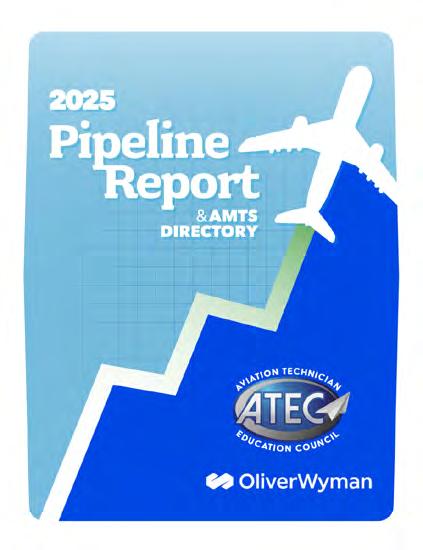
According to the 2025 Pipeline Report, pace of demand and retirements will help cut into, but not eliminate, the projected aviation mechanic shortage. (Image courtesy ATEC and Oliver Wyman)
The Pipeline Report shows that the FAA issued slightly more than 9,000 new mechanic certificates last year. The figure is just 4 percent below 2023s record-setting annual total of 9,401.

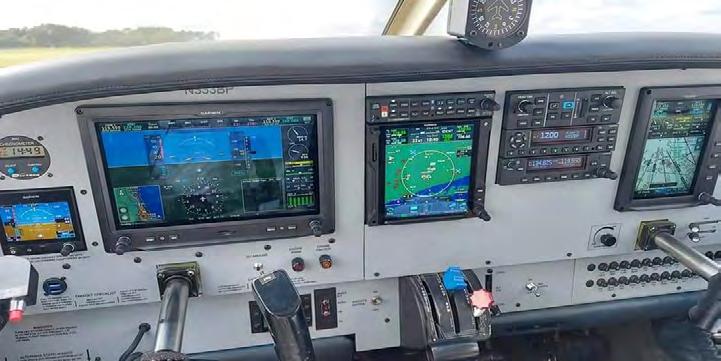

Repair Station for Avionics at
(KFPR) in Fort
Coast
have been serving pilots and aircraft owners in the Southeastern United States since 1990.
Coast International Airport (KFPR), 3800 Saint Lucie Blvd., Fort Pierce, FL 34946 Phone: 772-464-3148 • Fax: 772-464-3197 • Se Habla Español tcavionics@gmail.com • www.treasurecoastavionics.com
Aviation maintenance technician schools (AMTS) saw total graduates decrease just slightly (by 5 percent) from 2023’s record-setting 10,000plus. And enrollment increased by 9 percent, suggesting that efforts to increase AMTS contributions to the pipeline are paying off.
The U.S. civil commercial aviation maintenance workforce — including both certificated mechanics and non-certified technicians — includes more than 431,000 personnel. Over-supply is not a concern.
Demand from commercial air transport alone is expected to drive a 10 percent shortage in certificated mechanics in 2025. This gap will narrow to 7 percent by 2035, but will still represent a shortage of 10,000 certificated mechanics just to keep commercial passenger and cargo aircraft flying. Add in demand from business and general aviation fleets, and pressure on the technical workforce pipeline increases even more.
“We’re seeing some measurably positive trends at the grassroots level, building interest in pursuing aviation maintenance and the training needed to earn an FAA certificate,” said ATEC
President and WSUTech Vice President Aviation & Workforce Development Jim Hall. “Near-term challenges will include bolstering these trends while ensuring that we have enough specialized personnel, notably instructors and examiners, to support it.”
Among the notable trends:
• Two-thirds of new mechanics obtained certification through an A&P school, with the remainder earning certification through military experience (14 percent) or work experience (20 percent).
• FAA figures show one-third of certificated mechanics were engaged in general aviation or working for repair stations, air carriers, or AMTS in 2024. Certificated mechanics represent 61 percent of the air operator maintenance workforce, 22 percent of the repair station workforce, and 86 percent of the general aviation workforce.
• While AMTS enrollment rose 9 percent year-over-year, the A&P instructor workforce remained flat in 2024. This underscores the growing gap between teacher supply and demand and the challenges programs face in hiring and retaining certificated instructors.
• AMTS enrollment’s uptick is encouraging, but about one-third of available seats remain unfilled. The lack of awareness of aviation maintenance as a rewarding career path and instructor shortages are the leading contributors to below-capacity enrollment.
The Pipeline Report is produced annually by ATEC and Oliver Wyman to spotlight U.S. airframe and powerplant (A&P) mechanic workforce trends. It is composed of insights from an annual survey, analysis by subject matter experts in both organizations, and data from the FAA and other publicly available sources. Find the full report at atec-amt.org.

Non-towered airport operations can expose pilots to some peculiar hazards that may not typically be seen at towered airports. While FAA regulations and standard operating procedures exist that govern and maintain safe, non-towered operations, pilots must ensure strict procedural compliance and employ sound judgment to achieve that goal. Simple oversights or cutting corners in a non-towered environment may degrade flight safety more than the same infractions under the watchful eye of a Tower Controller. Accordingly, pilots must be extra vigilant when communicating and conducting operations at non-towered facilities.
This month, CALLBACK shares reported incidents that occurred during or associated with non-towered operations. Examine inherent risks and hazards, and ponder whether and how you could have mitigated each to enhance flight safety.
Part 91 – Takeoffs and Landings
This DC3 First Officer described a developing critical ground conflict and the action needed to mitigate the threat.
■ While operating out of ZZZ airport, we announced our intentions to take off via runway XX (a downhill runway), as is standard operating procedure for our crew, due to the size of the DC3 and downhill slope away from the airport. Normal traffic pattern arrivals call for the use of runway XY. While ZZZ is a non-towered airport, there is a facility and airport manager who will sometimes provide additional services for arriving and departing aircraft, such as advisory calls, weather updates, and parking information. As we took the runway after our CTAF call, the airport manager notified us that there was an aircraft on final who failed to make a CTAF call. Our aircraft had just lined up on runway XX, and the offending aircraft was…at approximately 500 feet on final approach. Due to the opposite direction taxi and checklist duties, our crew could not see the other aircraft until we were aligned on the runway. We made 3 attempts to contact the aircraft on final and tell them to go around. UNICOM did the same. The aircraft continued its approach, and at approximately 300 feet when it became apparent that the aircraft was not initiating a go-around, the Captain executed an evasive taxi into the gravel
and cleared onto the taxiway to avoid the landing traffic. The 172 continued its approach, landed, and taxied clear. UNICOM then let us know that the runway was clear, and we again announced our intention to depart runway XX. With no other traffic, we departed without incident. Upon recovery, the airport manager notified us that the offending 172 was a student pilot with an instructor and they were on the incorrect frequency. Apparently, they never noticed the DC3 on the opposite end of the runway and, because of the lack of radio communications, continued their approach.
A medium-large transport First Officer described curiosity and caution over terrain clearance during departure while ATC inspired respect for obstacle departure procedures.
■ ZZZ is uncontrolled.… Holding short of the runway, we called ZZZ Center and received our clearance to ZZZ1…as filed. We had planned for the ZZZ obstacle departure, which reads to turn right direct to ZZZ VOR, then from ZZZ climb in holding until passing MEA/MCA. We were familiar with the terrain, had briefed the grid MORAs, had terrain radar on Navigation Display (ND), and had the enroute chart open. Weather was night VFR. After takeoff, approaching the ZZZ VOR, we were identified by and in contact with ATC. We were climbing at a rate that [made it] clear that terrain separation wouldn’t be an issue. We were approaching the MSA and…decided we did not need to enter the hold, but rather to turn enroute as filed. We were of the mindset that once in contact and identified…ATC would take over both terrain and route clearance/ planning.… No further instructions were given. Out of curiosity, we queried ATC if they needed a specific altitude to continue on our route, or if they had a minimum vectoring altitude [that] they needed us to climb above. They reminded us that terrain separation was our responsibility at that time, but that if we had any doubt, they recommended a heading of 170 degrees. While terrain separation was never in any doubt…to ensure we were all on the same page,
















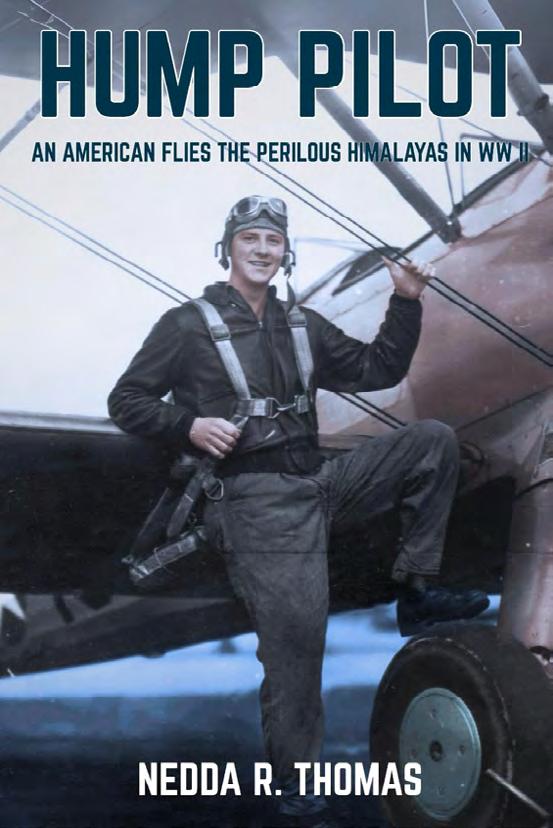
"Hump Pilot is as engaging a read as it is informed and informative. A first-class military aviation history!"
– Midwest Book Review
"Hump Pilot provides an entertaining window into what it was like to fly cargo over the world's most dangerous air route, in the worst flying conditions imaginable. A spirited account!"
– Aviation History
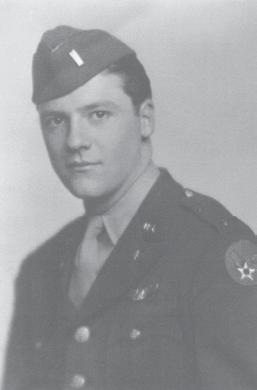
“Descriptions are vivid and engaging, adding a human face to the drama created by perilous missions over a vast mountainous wasteland. Well worth reading.”
– WWII History
"By telling this story in readable language anyone can appreciate, Nedda Thomas conveys how dangerous it was. You don't have to be a military veteran or an aviation buff to love this fantastic true account."
– Robert F. Dorr, Mission to Tokyo, etc.
"Thomas has written a dramatic history centered on her father (whose) brassy dedication and decency come across. However, the truly engrossing tale is the amazing Hump drama that ensures the book does a winner's barrel roll overall."
– Asia Sentinel
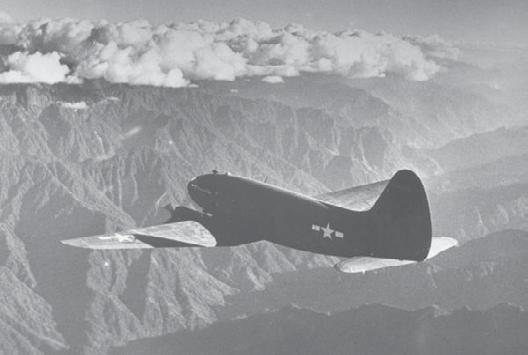
Continued from Page 13
we elected to turn…to the suggested heading, and passing XY,000 we were cleared direct to ZZZ1 VOR and continued our flight as planned. In hindsight, we should have entered the hold at ZZZ [VOR] and completed the obstacle departure routing, including a climb to at least XX,200 ft. (MORA) and requested direct routing, or to XZ,000 ft. (airway MEA) and continued as filed.… The radar altimeter never activated, and the terrain radar display gave us no cause for concern. The enroute chart was displayed, and MORAs were extensively briefed (since it was night and uncontrolled). However, in essence, we deviated from the obstacle departure procedure, and thus also deviated from the Operations Manual procedure….
An Embraer First Officer recounted how a warning system and instrumentation alerted this crew to the threat.
■ On arrival into ZZZ during the descent, setting up to enter the left downwind for [Runway] XX, we had the airplane descend down to 9,000 ft. for terrain to ensure 1,000 ft. clearance. Visual contact was maintained, as the moon was full at night to provide adequate visual separation. As the Captain (pilot flying) began to turn southeast to enter downwind, he requested 8,600 ft. for traffic pattern altitude. As the turn commenced, the RA began to show altitude and indicated a 1,300 ft./min. descent. Due to the rate of descent close to terrain, the gear warning sirens went off. The Captain then took controls off autopilot and increased thrust to level off. The warning cleared in no more than 3 seconds. We continued to land with no issues. Cause: Descent rate close to terrain in sight. Suggestions: Possibly…slow rate of descent or stay higher from terrain or maneuver to the side.
This CRJ900 First Officer got a small self-induced surprise shortly after breaking out during a real weather approach.
■ As we were approaching ZZZ, I as the pilot monitoring, tuned to the CTAF frequency for the airport.…The Tower was closed. I mistakenly tuned to the wrong frequency and failed to double check…the approach chart.… We got cleared for the ILS Runway XXL approach. We were then told by Approach Control to switch to advisory frequency since the Tower was no longer in operation. In our approach brief, we men-

There are more than 5,000 public-use airports in the United States and most are categorized as non-towered. If you have trepidation about self-announcing on the Unicom visit AOPA’s Safety Center to refresh your knowledge and improves your airport etiquette. Go to aopa.org for more information. (Photo courtesy AOPA)
tioned the anticipated threat of Tower being closed. The [AWOS] weather had mentioned that there was snow removal in progress at the airport, but we assumed…as it was past midnight, this may not have been accurate at our current arrival time.… Established on the approach, we… fully configured prior to the FAF. We were currently in IMC and making position reports. We did not hear any replies or anyone else on the frequency, but did not find this odd since it was past midnight local time. At the time there was some task saturation with conducting the approach in icing conditions at night and not having flown the CRJ900 frequently. As we were making position reports on the ILS, we eventually broke out from the IMC a couple hundred feet above our DA. We then saw snow plows and snow brush trucks on the runway.… Seeing this, we immediately conducted a goaround for the missed approach. After performing the missed approach and after running the appropriate checklists, we contacted approach to inform them we went missed due to snow plows on the runway. They asked if we had heard anything from the snow plows as we made our calls, and I replied that we had not, still under the assumption that we had the correct frequency. I did not know how to get in touch with the plows if they had not responded to CTAF, so I went to my Electronic Flight Bag (EFB) to find the Ops frequency. It was at this point that I finally double checked the frequency and realized my error. We corrected the issue with putting the correct frequency in COM 1 on the second approach attempt and gave the snow plows and trucks plenty of time to get off the runway so that we could land. The flight then landed safely in ZZZ
without incident.… I needed to double check the frequency that I input, especially seeing that, more than likely, there was not going to be any traffic in the area.… It would be unlikely that we would hear anyone else on the CTAF frequency, thus having to double check that we tuned the correct frequency. Part 91 –Decisions and Consequences A C172 Flight Instructor described approach decisions and the sequence of events that led to this unwanted outcome.
■ I was on the downwind for [Runway] XX when a corporate jet was inbound to XY, the opposite runway. They were 8 miles out. I offered to do a 360 for spacing to allow them to go first, and they said no, go ahead. Communication was fine, but then they were [on a] 3-mile final as I got over the runway. In an attempt to get off the runway quickly, I sped up, bounced the aircraft a few times, and the taxiway I was trying to get to (taxiway 1) went past me as I had too much speed. I then tried for taxiway 2, and I also had too much speed to slow down and make the turn to get off. At this point, the…jet decided to enter the downwind for XX, but it was too late for me… I wasn’t able to stop in time for taxiway 2. I went in between two taxiway lights into the dirt and popped back onto the runway.… No damage…occurred. I then taxied all the way to [taxiway] 3.
Editor’s Note: The reports featured in CALLBACK are offered in the spirit of stimulating thought and discussion. While NASA ASRS does not verify or validate reports, they encourage you, the readers, to explore them and draw your own conclusions.





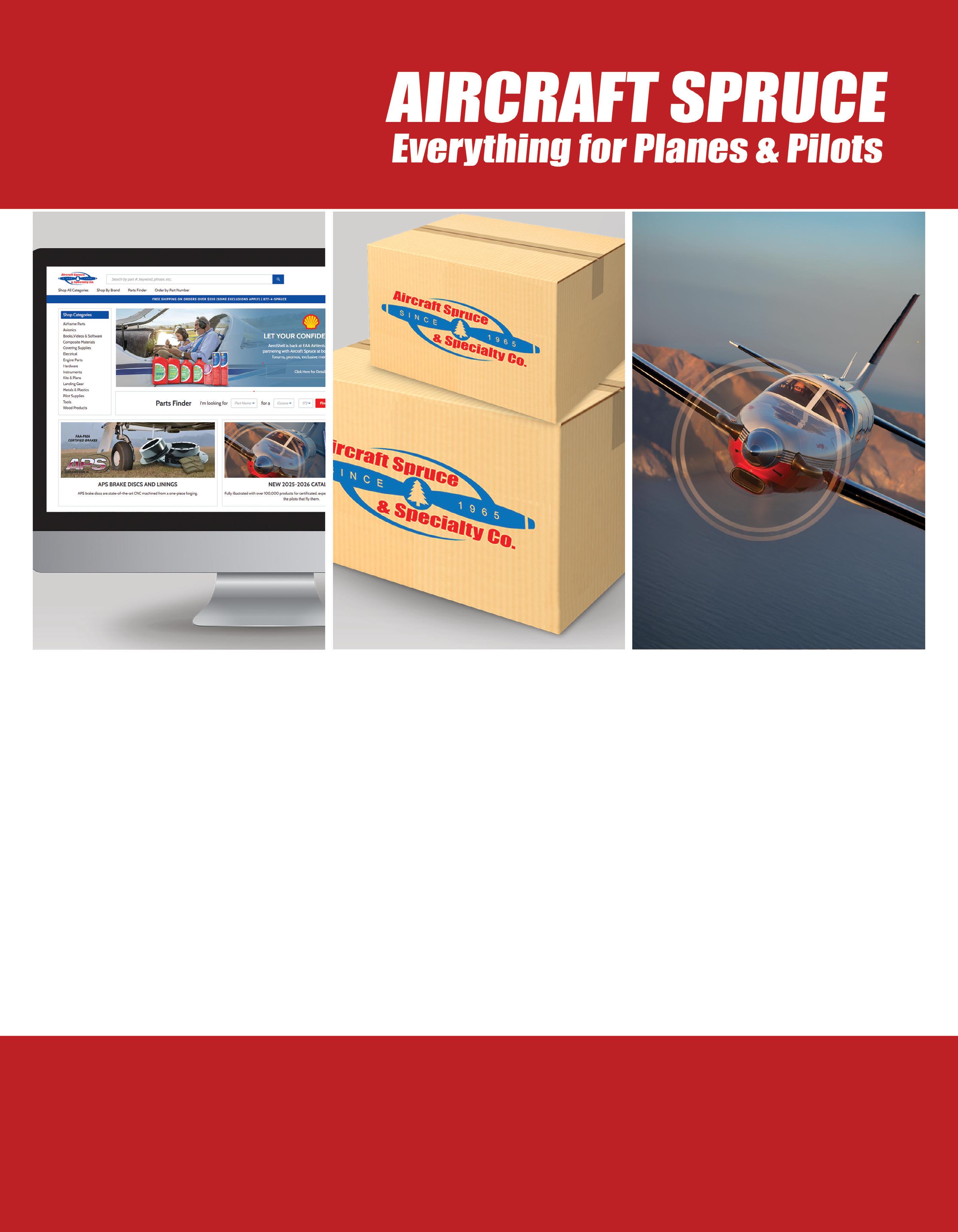










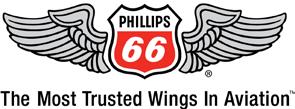











By Paul T. Gleaner, M.S., Associate Editor
Brian Liddle can draw almost anything but has a passion for drawing airplanes. It was a pleasure to meet him and talk to him at EAA AirVenture where his work was on display.
In Flight USA PTG: Brian Liddle, if you would be so kind as to tell us where you were born and raised, how you got into art, and where you stand today in the industry.
Brian Liddle: I am 52 years old. I’m from Green Bay, Wis. How did I start getting involved in aviation art? Well, my parents, instead of showing me cartoons, they let me watch the movie Midway with Glenn Ford and Charlton Heston. When I saw all the fancy winning insignias and all the stars on the airplanes and I was enamored by that.
Moving on later in my childhood, I’ve been drawing since age 8, and around sixth or seventh grade at Parkview, Middle School in Green Bay, my teacher was having us do a large project that was going to be displayed in a local mall in Green Bay called Bay Park Square and he had little folders in the back of the room which, were cartoon characters but in the advanced section were World War II airplanes. They were like coloring book images. So, I asked him if I could draw a B-24.
He looked at me and said, “You want to draw that?” I said to him, “Yes!” He promised me that he would allow me to draw it as long as I paid attention to every line and every detail on that plane, do it as accurately as possible and by the way he taught me ¬– on his terms. The teacher’s name was John Gordon and he actually designed the letter ‘G’ on the Green Bay Packers’ helmets that you see today.
Carrying on, I continued drawing airplanes throughout high school and college and after I graduated from college, I wound up in a call center and I continued to refine my shapes in between phone calls and my coloring, and my shading and people started walking by my desk and that’s where I started getting the popularity and/or notoriety.
I continued to draw airplanes, refine my details, and learn more about shape and proportion. At the call center, some of the programs I’d worked on, the call volume wasn’t very high. So I would occasionally sell (a picture of a) cat or dog or baby picture or something to my co-workers; very seldom an airplane, but I always had a passion for airplanes, and I have continued to draw them for pretty much all of my life, and that brings us to – today, here at EAA’s AirVenture and the warbird area.
I’m here fulfilling a family dream that my mom and dad wanted me to try

and bring my artwork to EAA. So, I joined Warbird Squadron 32 out of Oshkosh, Wis., and I brought my various line drawings of aircraft to my wing leader, and she is currently the leader of Warbirds right now. I bring my artwork and display it here at AirVenture and many different other functions throughout Northeast Wisconsin and sometimes in Peru, Illinois and some of the smaller cities in Illinois. I’m pretty popular there at the TBM Avenger reunion.
At these little pancake and porky breakfasts and some minor fly-ins, I get a lot of attention. A lot of people come by and pay me compliments. And
sometimes I’ll sell occasional airplane prints or acquire a commission. Most of my prints are unlimited because I would say I’m in a growth stage, just starting out. I’ve been actually displaying my art for three years. I have done presentations on my artwork. I call it my journey as I will go to various EAA chapters throughout Wisconsin. I am also an aircraft preservation and education volunteer with the Commemorative Air Force; Wisconsin Wing and I’ve done my presentation for them as well. We have two aircraft which I’ve drawn: an SNJ Texan and a T-34 Mentor.
Continued on Page 19




Compelling content -


Professional Branding & Graphics
Powerful Web Sites & SEO
Social Media Management
Engaging Podcasts
Profitable Webinars
On-Site or Virtual Services
Studio Time Available in SLC
Sales Process Consulting & Tools articles, videos, and posts.
2026: July 20-26
2027: July 26-August 1
2028: July 24-30
2029: July 23-29
� Available in both Qref® Book, Card and new iPad editions
� Over 50 years of professional experience in every checklist
“EAA AirVenture is one of the aviation community’s major highlights each year, so announcing the dates for the next several years is important for enthusiasts around the world to begin planning their trips to Oshkosh,” said Jack J. Pelton, EAA CEO and Chairman of the Board. “We also realize that AirVenture’s dates affect the scheduling of many other aviation events, as well as other activities in Wisconsin, so it’s
� Written by Master CFIs with workflow and ease of use in mind
� Professional design, rugged construction
Beechcraft Bonanza A36 285HP1968-1983
Beechcraft Bonanza C/D 35 1951-1953
Beechcraft Bonanza J/K/M 35 1958-1960
Beechcraft Bonanza N/P 35 1961-1963
Beechcraft Bonanza V35 A/B 1966-1982
Cessna 150 1959-1977
Cessna 152 1978-1986
Cessna 172 Universal Universal
Cessna 172M 1973-1976
Cessna 172N 1977-1980
Cessna 172P 1981-1986
Cessna 172R 1998-2006
Cessna 172RG 1980-1985
Cessna 172S 1998-2006
Cessna 172S G1000 2005+
Cessna 177RG 1971-1978
Cessna 182P 1972-1976
Cessna 182R 1981-1986
Cessna R182 Skylane RG 1978-1986
Cessna 182RG Turbo 1979-1986
Cessna 182T Analog Gauges 2001+
Cessna 182T/G1000 2004+
Cessna 210N Centurion 1979-1984
Cessna Turbo 182T 2001+
Cessna Turbo 182T/G1000 2006+
Cessna Turbo 206H 1998+
Cessna Turbo 210M Centurion1977-1978
Cirrus SR20 Analog Gauges 2000-2003
Cirrus SR20 G1-G2 2003-2007
Cirrus SR20 G3 2007+
Cirrus SR20 Perspective 2008+
Cirrus SR22 G1-G2 2003-2007
Cirrus SR22 G3 2007+
Cirrus SR22 Perspective 2008+
Cirrus SR22 G3 Turbo 2007+
Cirrus SR22 Turbo Perspective 2008+
Diamond DA20 C1 1998+
Diamond Star DA40 2001+
Piper Archer II PA-28-181 1976-1994
Piper Archer III PA-28-181 1995-2002
Piper Arrow 180 PA-28R-180 1967-1971
Piper Arrow II PA-28R-200 1969-1976
Piper Arrow III PA-28R-201 1977+
Piper Arrow III Turbo PA-28R-201T1977-1978

important to have these dates finalized for multiple years in advance.”
EAA’s fly-in convention was first held in 1953 and has occurred in Oshkosh since 1970. More details regarding highlights of EAA AirVenture Oshkosh 2026 will be announced as they are confirmed. Learn more about EAA and AirVenture at eaa.org.

















Piper Arrow IV PA-28RT-201 1979-1982
Piper Arrow IV Turbo PA-28RT-201T1979-1990
Piper Cherokee 140 PA-28-1401964-1977
Piper Cherokee 150 PA-28-1501961-1967
Piper Cherokee 160 PA-28-1601961-1967
Piper Cherokee 180 PA-28-1801963-1973
Piper Dakota PA-28-236 1979-1994
Piper Cherokee Lance PA-32R-3001976-1978
Piper Navajo PA-31-310 B/C 1972-1980
Piper Navajo Chieftain PA-31-3501973-1984
Piper Saratoga SP PA-32R-3011980-1992
Piper Saratoga SP Turbo PA-32R-301T1980-1987
Piper Tomahawk PA-38-112 1978-1982
Piper Warrior 151 PA-28-151 1973-1977
Piper Warrior II PA-28-161 1976-1986
MANY MORE MODELS COMING SOON!


Since it was
in 2009, the Brown Arch plaza is now a tribute to AirVenture’s past and a celebration of all who dream of flight. (Photo
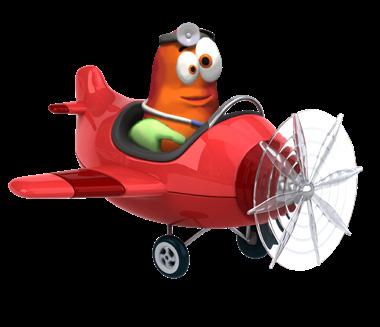




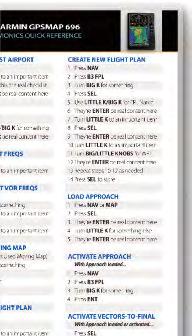



Avidyne Entegra
Garmin G1000 Non-WAAS
Garmin G1000
Garmin G1000 WAAS
Garmin G600/G500
Cirrus Perspective by Garmin
Bendix/King KLN 89
Bendix/King KLN 90B
Bendix/King KLN 94
Garmin GMX 200
Garmin GPS 400
Garmin GNS 430




Garmin GNS 480
Garmin GNS 530
Garmin GTN 750/650
Garmin GX Series
Garmin MX 20
Garmin 300XL/250XL
AnywhereMap ATC
AvMap EKP IV / IV Pro
AvMap EKP V (coming soon)
AvMap Geopilot II / II Plus
Bendix/King AV8OR
Bendix/King




Continued from Page 16
IFUSA PTG: What potentially famous aviators and/or organizations have you interacted with your lovely artwork?
BL: I give away some of my drawings to veterans of all the foreign wars: Vietnam, World War II, Korea, etc. I gave a P-39Q drawing called “Old Crow” to the last living triple ace from World War II, General Clarence Bud Anderson, and he accepted it with glee. I heard that he passed it on to another Commemorative Air Force member that owns a P-39Q in those colors before his death. Another famous veteran I handed an F-4 Phantom drawing to was Commander Duke Cunningham and Willie Driscoll. They are the only U.S. Naval aces from the Vietnam era that flew the F-4 Phantom. They shot down five aircraft and that was one of the first gifts I ever gave away to a veteran and he accepted it. I tried to get autographs from him and Willie so that people would be able to take a piece of history home with them. Another gentleman that I gave a drawing to is not
a veteran, he is a CIA volunteer from the Vietnam era. He used to fly a C-123 Provider. He got shot down over Laos. He wanted me to draw his aircraft. I gave him the original drawing as a gift, and I have one print on display at the Aviation Heritage Museum in Sheboygan Falls, Wis.
That is one of my goals. I have a big passion for displaying things such as my artwork in museums. In the future, I will be going up to the Richard I. Bong Center up in Superior, Wis. Richard Bong was a leading fighter ace of World War II with 40 kills in the P-38 Lightning. I have drawn a 24-inch by 28-inch original drawing of his airplane, named after his late girlfriend and wife, Marge. The center has graciously accepted the donation and hopefully they will use it.
I honor our veterans, and I try to draw my aircraft accurately. I would like to continue to draw these airplanes for veterans and keep the prints in their honor and sell the prints to maybe help their foundations’ finances to help them maintain their own warbirds if they are restoring any.

There are a few veterans I wish I could get in touch with. One of them would be USAF BGen. Steve Ritchie. He had a double kill in an F-4J Phantom during Vietnam. I have tried to contact him. Hopefully, we’ll get to meet sometime. That would be an honor.
Walked the Talk!)


My Services
Ghostwrite your Book or Articles
Engage your customers with • Gifts of short, attentiongrabbing Ebooks
(415) 320-9811 • botajet@gmail.com
Website & Blog: www.bertbotta.com https://www.facebook.com/BertBotta1 https://www.linkedin.com/in/bertbotta/ NetJets Pilots & F/A Facebook page: https://www.facebook.com/groups/447755025256768
E-mail: botajet@gmail.com
Website: www.bertbotta.com

IFUSA PTG: Highlight what brings you to EAA’s AirVenture?
BL: My artwork. Well, I’m here to honor the fallen veterans and to honor the ones that are still with us with my passion for drawing aircraft. I’m surrounded by nothing but solid inspiration: Warbirds from all different eras. Now World War I; it is just replicas now, but I’ll throw some of them in there once in a while and I’ll do my research on those. With the Commemorative Air Force, they have some pretty nice, pretty colorful birds and some great people to work alongside. What I do for them is I will donate some money back to them after I sell a print so that they can buy airplane parts or fill up their plane or have their own pancake and porky breakfast. What better place to sell artwork than at the world’s largest aviation based phenomenon? (704,000 attendees, err, airplane nuts and 2,543 including: 995 vintage aircraft, 910 homebuilt aircraft, 361 warbirds, 101 ultralights and light planes, 75 aerobatic aircraft, 74 seaplanes and amphibians, 18 rotorcraft, and 9 balloons.) We’re talking about hundreds of thousands of people. Learning. Inquiring. Observing. Showing their passions and I am very honored to share my art-
work with every soul on this flightline. The camaraderie? I’m a man of attention. I like attention and I do my best drawing when people are watching me.
IFUSA PTG: Now, tell us about this special P-38 drawing you are about to show me and where do you see yourself in the future?
BL: So, I do have the 24-inch by 28-inch P-38 drawing on hand as we speak and it will be photographed. Then, as soon as AirVenture is over, I will be flown up to Superior, Wis. by a friend of mine. So it will be put on display. Which brings me to the future. What do I foresee in the future with my artwork? Well, I see a lot more drawings. I see commissions and I do see other drawings other than their planes, but we’re going to stay aviation-based right now. I see hopefully more museums in my future and my stuff on display throughout the United States; worldwide would be really nice. I will have one of my prints in Israel. I’m not sure in what city, but I did sell a print to a couple of Israeli gentlemen, and they are going to take it to a city near Tel Aviv. I do have some more artwork in Romania and across the border, I have a few pieces in Canada. But my goal is to keep making connections with museums and with important people. I mean, all of you are important. I wouldn’t be doing this if it wasn’t for the history and people like you. If it wasn’t for those foreign wars, I wouldn’t have anything to research or draw… And then there’s


EAA’s Young Eagles program, which over three decades has become the largest youth aviation education program ever created, is focusing its efforts on reaching 2.5 million Young Eagles flown by EAA AirVenture Oshkosh 2026.
“From those first Young Eagles flights at Oshkosh in July 1992 to today, more than 50,000 EAA-member pilots have shared their time, aircraft, and knowledge to open the world of flight to young people,” said Jack J. Pelton, EAA CEO and Chairman of the Board. “We now see its effect in developing two generations of pilots. We are now calling upon EAA members to reach the next big milestone of 2.5 million Young Eagles flown in the next 10 months and to celebrate this achievement with us at
Oshkosh next July.”
As of Sept. 24, 2025, there have been 2,453,776 Young Eagles flown. Those Young Eagles have been flown in aircraft ranging from hot air balloons to corporate jets on every continent except Antarctica. The success of the Young Eagles program is also the foundation of EAA’s expanding youth aviation education resources, which now include AeroEducate, Sporty’s Learn-To-Fly course and Young Eagles Connect, the EAA Air Academy, and chapter-based Ray Aviation Scholarships.
“As I visit Young Eagles rallies, the volunteer leaders often tell me the same thing — there are plenty of eager kids ready to go flying, but more pilots are needed and always welcome,” said Jimmy Graham, Young Eagles chair-
man and retired NFL All-Pro tight end. “We aviators all have had that one flight that sparked our love of aviation, so it’s time to get involved and sign up to fly Young Eagles. You can make a difference — who knows where that young person could go because of your willingness to take them flying?”
EAA is offering recognition for Young Eagles pilots who join the “25 for 2.5” campaign to reach 2.5 million Young Eagles in the coming months. In addition, participating EAA chapters that assist in new volunteer pilot recruitment will be eligible for extra Young Eagles credits that can be used to obtain further resources for Young Eagles rallies or cover tuition fees of deserving youths for the EAA Air Academy residence camp held each
summer in Oshkosh.
More information regarding these recognition levels and incentives is available at EAA.org/Fly25YE.

EAA’s Young Eagles program is focusing its efforts on reaching 2.5 million Young Eagles flown by EAA AirVenture Oshkosh 2026. (Photo courtesy EAA Young Eagles)
By Annamarie Buonocore
Introduction
EAA Young Eagle events are local airport events that bring youth to the local airport for their first flight. For the last five decades, the Experimental Aircraft Association (EAA) has been hosting these events through local flight schools, and the program has given thousands of youth the opportunity to explore flight for the first time. Dedicated pilots and CFIs volunteer their time, airplanes, and equipment to give youth the ride of their lives. These events happen year round throughout the U.S. If you have never attended one of these events, here are five great reasons to do so. You don’t have to be a CFI or even a pilot to attend. Simply going out to the local airport as an aviation enthusiast can bring great benefits to your passion for flying.
Support Youth:
The first reason is a no-brainer. Attending these events support local youth who might be interested in flying. We all know that the aviation industry needs new pilots, aviation mechanics, and other professionals in the air and on the ground to keep the industry moving forward. Simply being there shows local youth and their families that the industry comes together to make these events happen. When we make these events look big and popular, it sends

Launched in 1992, the mission of the Young Eagles program is to introduce young people to the world of aviation. The EAA’s network of more than 50,000 volunteer pilots have given over 2 million kids, ages 8–17, their first free ride in a general aviation airplane. EAA Chapter 1268 offers these free Young Eagles rides at Sonoma Skypark every month on the second Sunday, from 9:30 a.m. to 11:30 a.m., weather permitting. (Photo courtesy Sonoma Sky Park)
a clear message to families that this is more than an industry; it’s a community that comes together to support its people. While attending an event, strike up a conversation with a young person to learn more about their interest in flying or future goals. Share your experience with aviation. This is an allaround good feeling for you, the youth attendees, and the industry as a whole. This month, In Flight USA staff had the honor of attending an event at Sonoma
in Sonoma, Calif. The youth in attendance were inspiring and had great aspirations to continue the legacy of general aviation.
See Cool Airplanes:
While Young Eagle events are not as big as airshows or even local airport days, many pilots come to the local airport, and they bring a diverse array of airplanes that can be great fun to view (and maybe touch and feel). At this month’s Sonoma SkyPark event, we had two Cessna 172s, a Cessna 150, a Piper Cub, and most fascinating of all, a gyrocopter from MagniGyro. This small green tandem two-seater had youth and adults wrapped around its rotor, making the event a great opportunity to learn about a new option on the market that makes for a thrilling adventure. For more information, visit www. magnigyro.com.
Meet Flight Schools, CFIs, and DPEs:
Young Eagle events can be a great opportunity for prospects to choose a flight school, CFI, or even DPE. They can also be great networking events for aviation professionals. At this month’s event, we had the pleasure of meeting the staff and a couple of CFIs from Mike Smith Aviation in Napa, Calif. To learn more visit, https://mikesmithaviation.com. A Young Eagle event near you is sure to have a flight school, CFI, or even a Designated Pilot Examiner.
Attending one of these events is a great first step in launching an aviation career.
See/Learn About a New Airport:
Perhaps the best part of attending a Young Eagles event is exploring a new local airport. Many who are new to aviation are not aware of the many small, medium, and private airports throughout the country or that many airports do not have scheduled flights, like SFO. Visiting a local airport can expose you to new aviation businesses, airport cafes, and give you important information about how an airport tower works (if it’s a towered field). This month’s event was at a very small airfield that is often overlooked. Sonoma SkyPark has two active runways, Runway 08 and Runway 26. It is a non-towered field conveniently located in the heart of Sonoma County. In addition to our Young Eagles event, we met some hot air balloon pilots and passengers who had just returned from their adventure over the Sonoma Valley. Check out Sonoma SkyPark at www.sonomaskypark.com.
Conclusion:
So, if you are looking for a funfilled aviation activity where you can support youth, volunteer, network, and learn about a new local airport, attend a Young Eagle’s event this year. For more information, visit https://www.eaa.org/ eaa/youth/free-ye-flights. Find a free first flight for a youth in your life today!
So after all of the medical misadventures resulted in only 11 hours flying in the last 12 months, all of that with instructors, the question is whether to sell the RV-9A and call it quits or keep going.
The heart attack issue was resolved, but the FAA found something else in that special issuance application to be concerned with, so I’m again waiting for a medical.
Meanwhile, I’ve been flying with two CFIIs from the local flight school, both women and both very sharp. With my encouragement, they call me out any time my procedures are sloppy (too much of that) and challenge my deteriorated aeronautical knowledge. I used to be an FAR trivia lawyer with the best of them, but these days...
Anyhow, yesterday we went to a nearby airport to get gas. After all the autopilot flying I’ve done, my hand flying skills are no longer at ATP standards. Anytime I have to fool with the avionics or spend too much time talking, the needles start to wander. This flight was to be hand flown all the way, VFR. And I’d not seen the local scenery in a while.
This was also an opportunity to have the pattern to ourselves, something that never happens at home base Savannah, Class C airspace. I hadn’t done a power off 180 since forever, so that was on the agenda. She advocated doing it at best glide speed, but that made no sense to me... speed up or slow down, both will decrease your glide distance. Somehow 80 knots felt right as we passed the numbers on downwind, flaps 10 (degrees) and a gentle bank.
I knew we had an abundance of altitude, so I went to flaps 10 early. Some planes get annoyed if you retract the flaps, but it’s benign in the RV-9A, so if I’d underestimated the glide and needed to re-
tract the flaps, no problem. Other planes, other techniques...
Around we went in the turn, bank, airspeed, and pitch nailed, flying like I’d done this every day for the past month. As we got closer, it was time to get rid of some of that safety margin, so flaps went to 20 and then 40.
This runway has trees at the end, and we cleared them by the desired mild-pucker-factor amount, still exactly at 80 knots, with excess speed to handle any downdrafts or misjudgment. The instructor would have preferred more altitude over the trees, but that altitude would have been hard to dissipate unless we were a bunch slower. I chose speed.
Once past the trees and with the airport boundary fence not a factor, the RV-9A went into a forward slip, nice as you please, exactly on centerline, easy to control. The RV-9A doesn’t come down anywhere near as enthusiastically as my old RV-8 did with full flaps, so even with a maximum effort slip, touchdown was 200 feet long. Close enough.
That approach was extremely satisfying, even if the touchdown wasn’t perfectly smooth.
So now the flying decision. I get immense satisfaction from flying extremely well, and want to get my skills back to where that skill level is the daily norm, not something worth writing about. When I turn off the 10-inch screen and fly with the G5 standby, those skills need work. I’ve not flown a for-real non-precision approach in forever, and there are all the commercial maneuvers that are new (to me) in the last 50 years. And there are still corners of the flight envelope to explore, and to share with my CFIIs, who aren’t accustomed to maneuvers beyond 30-degree bank like we used to do them.
Continued from Page 9
“We built a brand-new NOTAM service from the ground up in record time,” said FAA Administrator Bryan Bedford. “It is resilient, user-friendly, and scalable, and will significantly improve airspace safety and efficiency.”
NOTAMs communicate temporary changes such as runway closures, airspace restrictions, and obstructions to pilots and flight planners. More than 4 million are issued annually.
The new NMS has a streamlined, modern interface. It provides near-real-time data exchange, enabling efficient data flows and
But some things are candidate for getting dropped. Even if I get a $cooter at Oshkosh, I may not have enough energy for another Oshkosh, even after all the daily workouts here. We will see. Kitplanes and Flying have been neutered by AI-generated text, and Sport Aviation seems bland. Things are changing, and not as I would prefer.
But my little world, flying locally in the RV-9A, is still immensely satisfying, and worth keeping for another while.
The story begins a few engine starts ago.
Start #1. Engine started fine, ran fine, failed the runup spectacularly. Into the shop, bottom plug on #3 cylinder was oil fouled. I gave them a new Tempest plug. Engine ran up just fine. My CFII got to bill me for 0.1 hours.
Start #2. Engine started fine, ran fine, failed the runup spectacularly. Back into the shop, bottom plug on #3 cylinder was oil fouled again. Apparently, some Tempest plugs had problems from the factory and maybe the one I gave them was bad. They cleaned all the plugs, all of them looked good. Engine ran up just fine. Who knows. 0.1 again.
Start #3. Engine ran fine, great flight.
Start #4. Engine started okay but sounded a little funny, runup at 1600 RPM in front of the hangar was fine, failed the normal runup spectacularly. Back into the shop. My CFII got to bill me for 0.1 hours again.
Start #5. The mechanic started the engine to taxi the plane to the shop, and it ran poorly. Backfirin’ and spittin’ and raisin’ a ruckus. When he got to the shop, the engine was running just as nice as you please. So they knew it wasn’t me...
I had a spare set of overhauled mags

on hand, and we discussed replacing both mags in the plane. I suggested looking inside the left mag to see what it looked like before they did the swap, though. (The original mags were replaced at 500 hours by a set of overhauled mags a friend gave me, if I recall correctly. One had 100 hours, one had zero. And as of this morning, these new mags had 350 hours or so in my RV-9A.)
So what did they find? The right mag, not the left mag, was full of oil and had other egregious problems that I’ve not yet got the details on – so maybe the mags were wired with the leads swapped. And it looked like the P-leads were backwards, too. And the other mag had a minor issue as well.
The plane is back in the hangar and the runup was pretty good, but the mechanic thinks that he should have cleaned all the plugs again. Anyhow, it is returned to service. And the mags are off to be overhauled/rebuilt, whatever the correct term is, and they’ll take their turn on the shelf. And the engine runs fine. Finally. Two great flights later, and we can trust the engine again. At least, as much as one ever trusts a single engine.
I don’t think it’s ready to quit flying with me, either.
better stakeholder collaboration. The system is securely hosted in the cloud and has a scalable and resilient architecture designed for high availability.
The FAA accelerated its NOTAM modernization efforts after the existing system experienced repeated failures, including outages that heavily impacted travelers.
The FAA used a streamlined, innovative vendor challenge to cut through red tape to get this work done as fast as possible. In collaboration with CGI Federal, the agency developed the new service while engaging with the stakeholders who use it.
The new initial core distribution ser-
vices will operate in parallel with the existing legacy NOTAM System for the next few months.
The next phase of the NOTAM modernization will be complete in February 2026 when the new service fully replaces the legacy and aging U.S. NOTAM System (USNS) that runs on outdated hardware and software.
Full transition will be complete in late Spring 2026. This involves migrating more than 12,000 NOTAM users worldwide, enabling the retirement of the second legacy system called the Federal NOTAM System (FNS). This transition will establish NMS
as the single authoritative source for all NOTAMs, delivering a modern, reliable foundation for the national airspace system.

A new NOTAM service called NOTAM Management Service (NMS) began operations in late September with full transition expect by Spring 2026. (Image Canva art)
Road #3
CA 94945
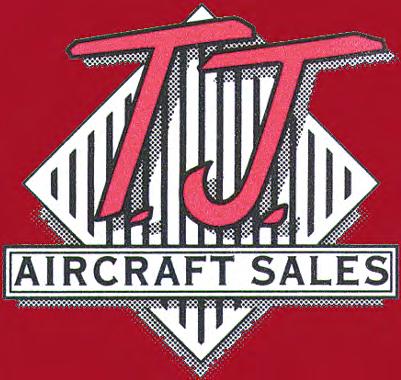




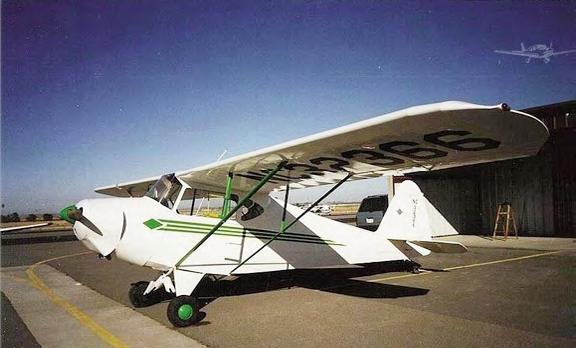
PRICE REDUCED! If a classic, big, brawny, powerful, roomy, impressive, easy to fly plane with convenient entry interests you, we've got one. Shows very well inside and
CONTRACT. The world's most popular plane for training and fun flying. Reliable, long-lived, Lycoming O-320 engine with less than 700 hrs. Presents exceptionally well both inside and out. Call T.J. for
STEAL at 69.9K! Great performing 160 HP airplane with 884 lbs of useful load. Sharp interior and sporty exterior.
PERFORMANCE! Super fast. Super high-flying in pressurized turbineengine comfort with 750 horses. What happens when you buy a jet? You have to sell your turbo-prop. Even a gorgeous one like this.
PRICE REDUCED! A breath-taking total restoration of a classic WWII era primary trainer. Fly solo from the front seat. An absolute hoot to fly. Comes with a spare overhauled pickled engine. Add $2,500 to price with electric start.
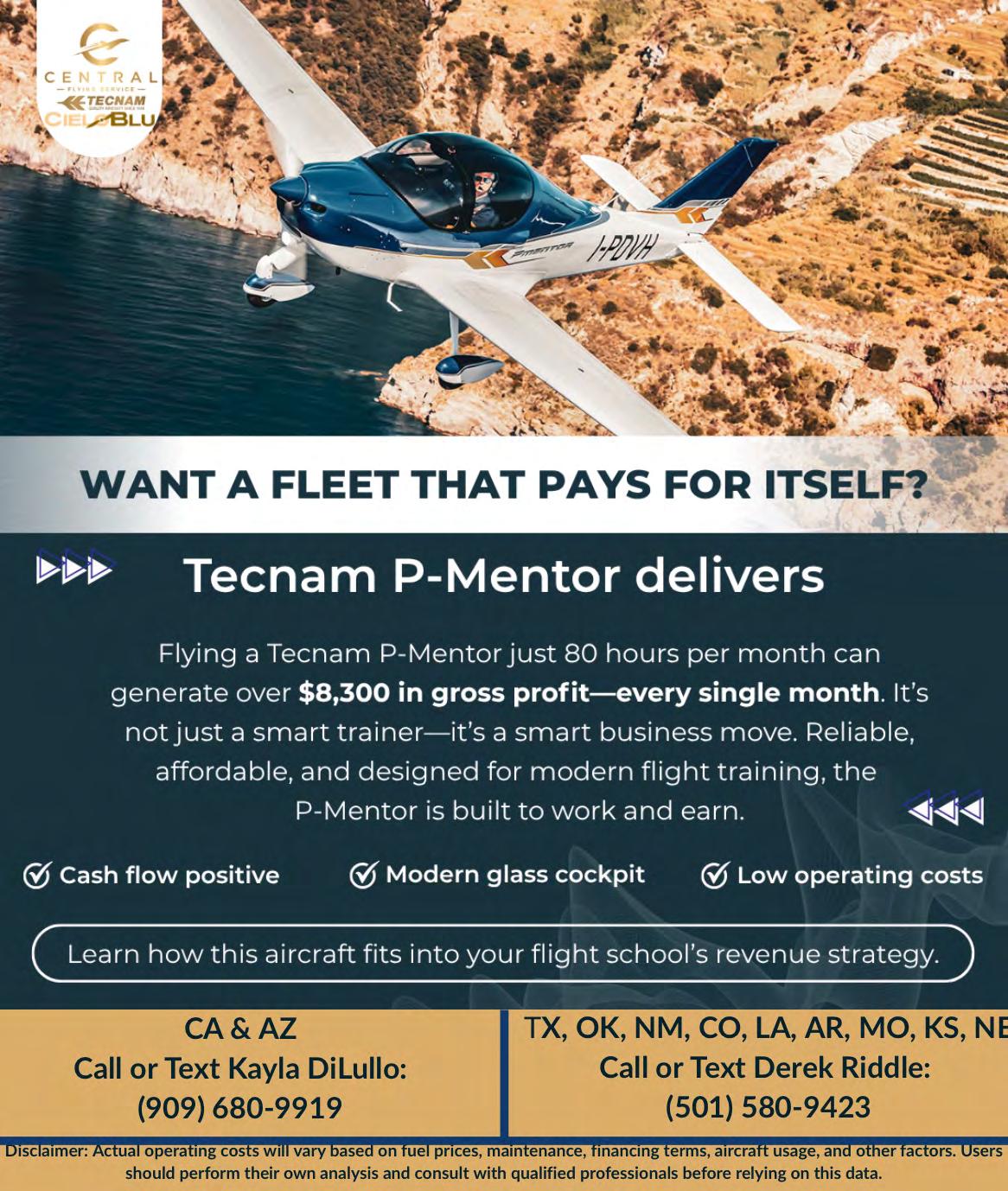
By Lea Buonocore
The Santa Monica Airport is located in Santa Monica, Calif. and holds the important title of being one of the oldest airports in Los Angeles County. The airport first began operations in 1923, and was originally referred to as Clover Field. Clover Field held vital roles in aviation for Los Angeles County, including being a production site for Douglas Aircraft. This airport has a strong and important history tied to the aviation community, especially for the military history and for manufacturing.
Today, the Santa Monica Airport, and its adjacent surroundings, is home to a recreational park, a restaurant, and a theater. There are many ways individuals and families enjoy the Santa Monica Airport and engage in interesting and educational opportunities related to piloting and aviation.
Unfortunately, the Santa Monica Airport is currently falling on some challenging and uncertain times. The City of Santa Monica has announced that the airport will be permanently closing at the end of 2028.
This would be a significant loss to the community, as this airport carries import-
ant historical relevance and the aviation community of the Southern California relies on the airport for recreational and business operations and relief from other busy airports in the region. The airport administration has considered delaying the closure due to JSX applying to use the facility for their commercial operations. However, the city of Santa Monica is holding its ground by stating that the airport’s closure date will remain.
In mid September of 2025, JSX created a proposal to use an ATR 42-600, a turboprop jet, which typically seats around 25 passengers. JSX claims that this advanced jet uses technology that reduces noise and consumes less fuel than your typical jet. JSX hoped this would be something that the airport would be interested in and hoped this would possibly be a turning point for the airport to possibly keep its doors open.
Economically, the Santa Monica Airport has gone through many changes over time. The airport always made a significant economic contribution as it served as a hub for general aviation, flight education, maintenance service for aircrafts, as well as a support for local businesses. Unfortunately, as time has passed, the airport

has suffered due to concerns about noise and pollution. Residents of Santa Monica are concerned as this noise and pollution is in local proximity to schools and neighborhoods. Prior to these complaints in 2015, the airport originally brought in a healthy financial revenue for the city of Santa Monica, as it was able to sublease some of its commercial space. However, this financial stability did not last long and landed the airport in significant financial debt. Consequently, the city of Santa Monica took control over leasing decisions, which did not allow the airport as much freedom for leasing options to create revenue.
Another important aspect of this small airport is the businesses that exist within the airport. There is a flight training academy as well as aircraft suppliers, and providers of fuel and hangar space. These are all very important to the aviation community and are significant players in the behind-the-scenes work of aviation. Also, the airport serves emergency responders, including fire and medical, and other ancillary aviation and transport uses.
The Santa Monica Airport also plays a significant role in relieving air traffic
Continued on Page 40
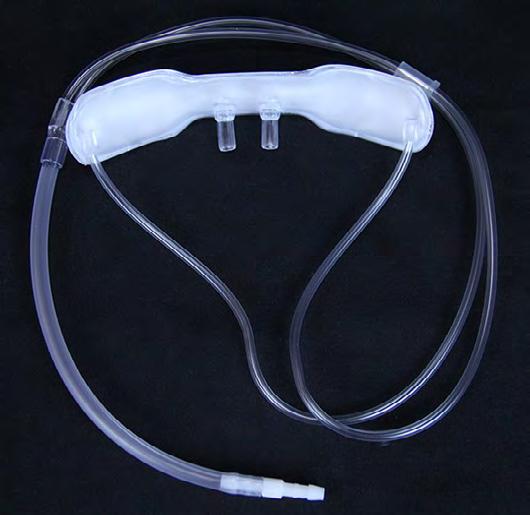

AOPA and aviation organizations have fought for years to demonstrate the value of investing in the infrastructure and future of Santa Monica Municipal Airport. It is where the next generation of aviators train at flight schools, and where nonprofit organizations operate for the benefit of the community. The airport provides a hub for emergency response and disaster relief operations, and provides community access to charitable organizations such as Angel Flight, which provides medical transportation to people in need. The airport also has the potential to be an incubator for future aviation technologies. Unfortunately, the airport is slated to close in December 2028. (Photo by Mike Fizer, courtesy AOPA)



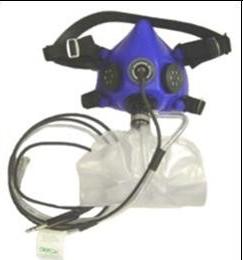





By Jay Wiles, AOPA
The AOPA Foundation opened its scholarship application window on Oct. 6 and unveiled a new, streamlined process that shortens wait times and helps current and future pilots put their scholarships to work faster.
Previously, the application window was open for five months, which was followed by several months of processing and selecting recipients.
Now, there will be two shorter application windows each year, with award decisions announced soon after. The application period that opened Oct. 6 closes on Dec. 31, with notifications to recipients beginning in February.
The next scholarship application period runs from April 1 to June 30, with notifications to recipients beginning in August.
“The AOPA Foundation scholarship
program is more popular than ever. Earlier this year, we awarded more than $2 million to nearly 400 people. With these changes, applicants will learn their results sooner and move forward with their training faster than before,” said AOPA Scholarship Manager Taz Thomas.
There are a wide variety of scholarships available through the AOPA Foundation. With generous support from the Ray Foundation, up to 100 scholarships are offered annually to high school students and teachers. Each year, up to 90 students and 10 teachers receive $10,000 or more toward training for their private pilot certificate.
Other scholarships include funding for primary flight training, such as a sport or private pilot certificate, or to help pilots obtain additional ratings and certificates such as instrument, commercial, flight
instructor, or multiengine. The AOPA Foundation also offers several scholarships for non-flying pursuits, including mechanic and flight dispatcher training.
“Cost is often the biggest barrier to entry — it deters many who dream of flying or earning additional ratings or certificates,” said AOPA Foundation Senior Vice President Elizabeth Tennyson. “Thanks to the generosity of countless donors, we’ve helped change thousands of lives. Donors who support this program aren’t just giving a gift, they’re making a direct investment in the future of aviation.”
Applicants must meet scholarship-specific criteria and hold a current AOPA membership, which is free for high school students. Details can be found, and applications can be submitted at https:// www.aopa.org/training-and-safety/stu-

AOPA Foundation has revamped its scholarship awards to twice each year. (Photo courtesy AOPA Foundation by Chris Rose)
dents/aopa-flight-training-scholarships.
The AOPA Foundation is a 501(c)(3) charitable organization. Its scholarships and programs are not funded by AOPA member dues, but by generous donations from individuals and organizations. To learn how you can support its mission, visit aopafoundation.org.
The Aircraft Owners and Pilots Association (AOPA) released an updated electronic Flight Instructor Refresher Course (eFIRC) on Nov. 1. The online course, offered by AOPA’s Air Safety Institute (ASI), is one way to keep any flight instructor certificate current.
“AOPA is uniquely positioned to offer the most robust, up-to-date course for flight instructors,” said ASI Chief Flight Instructor and FIRC Program Manager Mary Kuehn. “In addition to revamping the entire course every two years, we also update it anytime a new law or regulation affecting flight instruction goes into effect. We work with AOPA’s government affairs team to understand it and AOPA’s Pilot Information Center to get insight into the questions instructors across the country
have, which helps us constantly improve our eFIRC to meet instructors’ needs.”
The course is made up of a series of modules designed to keep certificated flight instructors (CFIs) informed of current rules, regulations, current practices related to flight instruction and overall, enhance aviation safety.
The new course, which launches next week, offers two new electives:
• Getting Back into Flight Instruction, targeted at CFIs who haven’t taught in a while and are looking to get back into the industry.
• Sport Pilots and Light Sport Category Aircraft explores the FAA’s new Modernization of Special Airworthiness Certification (MOSAIC) rule, which was finalized and announced
Continued from Page 7
correct frequency set up on the number 1 or number 2 radio, and did you hit the correct flip/flop button? When combined with nav frequencies, it is easy to be looking at up to six (possibly more) frequencies being displayed at one time.
• Are you transmitting on the number 1 comm, but have number 2 selected?
• Sure, the radio master switch should turn everything on at the same time, but every comm gadget typically has its
own on/off function. If you fly a rental plane, remember that the last pilot may have set up the radios completely differently than you do.
• This writer encountered a very highend avionics package (corporate jet) that would pull up all frequencies associated with a selected IFR approach and auto tune the entire system… except it got the CTAF frequency wrong. Always trust your computer pro-
earlier this year, in greater detail. The first part of MOSAIC, which greatly expands sport pilot privileges, goes into effect this week.
“Since the MOSAIC rule was announced in July, AOPA has received questions about it from flight instructors and pilots every day,” said Kuehn. “In our course, we give instructors the information they need to know about this new rule — including certificate requirements, new endorsements they can earn, and the aircraft they will now be able to fly as these changes took effect on Oct. 22.”
The updated course will also include several user experience improvements. Thanks to feedback on the previous version, users are no longer timed by slide and instead can proceed through
the content at their own pace within each module, while still complying with the FAA-mandated 16-hour course requirement.
In addition, every module will include resource pages featuring relevant articles, videos, and more from reputable sources such as the FAA and AOPA.
“AOPA’s new eFIRC makes renewing a flight instructor certificate easier and more engaging than ever before, with all proceeds continuing to support ASI’s vital safety education efforts for the pilot community,” added Kuehn.
View and purchase ($124) the eFIRC from the AOPA website (aopa. org) or directly at https://aopa.org/training-and-safety/cfis/flight-instructor-resources/cfi-renewal.
gram… right?
• Just as soon as the technology became reliable, this writer always carried a handheld system as a backup. Never used it in flight, but very handy when standing by for an IFR clearance delayed by a ground hold… no need to keep the aircraft battery running.
Sure, just a few thoughts, all of which have been experienced by this writer. Just one more final suggestion, know your light
signals. Steady green = cleared to land… steady red = go around… flashing red = runway unsafe, go away… alternating red and green = proceed with caution. This writer has received all of these over the years and was glad that I complied. Perhaps most important, is the communication you hear, but you do not understand. Time and time again, an accident might have been avoided if the PIC had simply asked for clarification. The term “say again” might be your best communication policy.

One of the truly great things about being an aviation buff is the number of “Goodies and Gadgets” available to play with. Here In Flight USA has collected a few new ones worthy of your consideration.
Aircraft Spruce & Specialty Co. has been the supplier that aircraft builders, owners, pilots, and aviation businesses have depended on since 1965. They carry a wide selection of aircraft parts, building materials, avionics, and pilot supplies, all of which are offered on their website (www.aircraftspruce.com) and in the famous Aircraft Spruce catalog, now over 1,000-pages available for download or for free in print. You can depend on Aircraft Spruce for prompt shipping and competitive pricing on all orders.
Gift items for the pilot or aviation enthusiast on your holiday list… Look no further than Aircraft Spruce. Here’s a sampling to get you started.
2026 Sparta Ghost Warbirds Calendar

Take delight in this exclusive Ghost Warbirds calendar! This warbirds calendar breathes life back into those heroes of the sky. Each month showcases exceptional photographs of classic warbirds. Each 12-month calendar features a 15.5-inch by 2-inch imprint area with full-color 15.5-inch by 10-inch photos on premium paper and saddle stitched. Ghost Calendars are printed and assembled in the USA. Each calendar sells for $15.80.

The Bush Pilot bag is canvas with leather accents and carries an embossed leather Flight Outfitters patch on the front. The inside of the Flight Level has the signature Flight Outfitters orange, making it easy to find gear in a dark cockpit. There are two large padded side pockets for headsets. The large front zip pocket has four organization pockets, for chargers and other smaller items that tend to find their way to the bottom of other bags. The Bush Pilot Bag also features a pass through strap on the back to slide over rolling luggage handles and a leather shoulder strap pad. Each bag sells for $129.95.

The Bush Pilot Wallet is canvas with leather accents, and has a clear window that can display both a Pilot’s License and a Driver’s License. The wallet comes in a Flight Outfitters-logoed tin box, perfect for storing charger cables and other miscellaneous items in a flight bag. Features include six credit card pockets and a divided billfold. Each wallet sells for $29.95.

Overview of the most comfortable, most durable headset Lightspeed has ever made.
More comfortable
• Performance ear seals are tapered to provide a more natural fit, for greater comfort and stability
• Plush ear seals provide 20 percent more surface area than competitors, for a better seal around glasses frames and a more comfortable distribution of side pressure
• Larger cup cavity provides 50 percent more space for your ears, allowing the entire ear to fit comfortably inside, while preventing the pain caused by seals pressing against the edge of the ear
• Low-profile stainless steel headband follows the curve of the head for more comfortable distribution of weight and side pressure
More durable
• Rugged cables built around a Kevlar core deliver more strength and flexibility with less weight than standard
cables
• Nearly 100 percent of the headset is made from stainless steel and magnesium
• Magnesium ear cups are both strong and light, while delivering superior high-frequency noise attenuation
More clarity
• The Dual Aperture Disc microphone provides greater noise cancellation for clearer, more intelligible communications
• Exclusive, user-adjustable mic gain helps balance loud and soft voices in a multi-headset environment
• Front Row Center (FRC), stereo cross-feed technology, and redesigned speakers deliver crisp, rich audio and unparalleled music fidelity
Lightspeed performance
• Award-winning active noise cancellation (ANR) delivers consistent performance over a deep, broad range of low frequency noise
• Zulu 3 is backed by an industry-best 7-year warranty
The Lightspeed Sulu 3 ANR headset sells for $949.00 and comes with a choice of plug types: Dual GA, 6-Pin LEMO or Heli-U-174.
The Option is a lightweight, breathable glove designed for medium duty work. It features a TPR wrist closure and a low profile, single piece palm for increased tactility. Lightweight back of hand material maximizes air flow.
It features a single-piece palm with saddle, fourchette and fingertip reinforcements.

The Lift Avaition Option glove is available in sizes small through 2XL and in black, camo, grey and hiviz (bright green). Each pair sells for $19.65.
Float, fly, and find Good Green Fun™ no matter how you travel! The Green Toys™ Seaplane is ready for earth-friendly excitement in the sky or out at sea. Made in the USA from 100 percent recycled plastic milk jugs that save energy and reduce greenhouse gas emissions, this buoyant yellow and green floatplane features a spinning propeller and chunky, oversized pontoons perfect for coasting into any port. Specially designed to float when taken into the bathtub or pool, young captains can easily navigate from water to air and back again. No BPA, phthalates, PVC or external coatings, and also meets FDA food contact standards. Dishwasher safe for easy cleaning. Packaged with recycled and recyclable materials and printed with soy inks. The Seaplane toy, which is 9-inches long, by 9-inches wide and 5-inches high, sells for $25.55 each. There is also an airplane toy made by Green Toys in red and blue selling for $16.95.


Cute 10-inch blue plush airplane, that comes with three 4-inch animal finger puppets. Bear, dog and kitten are perfect for your little aviator! Each set sells for $19.95.
Look for Aircraft Spruce at the following event: • Nov. 17-20 – NAAA AG Aviation Expo, Reno, NV.

By Feras Shakatreh
Introduction
In aviation, a single maintenance error can have catastrophic consequences, which is why the industry operates under some of the strictest safety regulations in the world. Regulations are designed to standardize practices, min-
imize risks, and maintain public trust. However, concerns have emerged regarding whether excessive adherence to these regulations outweighs the benefits. Moreover, “over-regulation” refers to regulatory requirements whose marginal safety benefits are outweighed by the economic and operational burdens

Regulations are essential for ensuring safety in aviation maintenance, but over-regulation can create inefficiencies, increase costs, and reduce operational flexibility. (Photo by David Tulis, courtesy AOPA)
they impose which may lead to unintended negative consequences.
The Importance of Regulations in Aviation Maintenance
Regulations in aviation maintenance serve several essential purposes:
• Standardization: Ensures consistent maintenance practices across the industry.
• Safety Assurance: Minimizes the risk of accidents due to equipment failure.
• Public Confidence: Maintains trust in the safety of air travel.
Authorities like the Federal Aviation Administration (FAA) and the European Union Aviation Safety Agency (EASA) set these standards to uphold the highest safety levels in aviation.
While regulations are vital, over-regulation can introduce several challenges:
• Increased Costs: Strict adherence to numerous regulations can lead to higher operational costs for airlines
and maintenance organizations.
• Operational Inefficiencies: Excessive paperwork and redundant procedures can slow down maintenance processes, leading to delays.
• Reduced Flexibility: Overly rigid regulations may hinder the ability to adapt to new technologies or methods that could enhance safety and efficiency.
A study by the Cato Institute highlights that over-regulation can increase transportation fatalities as compliance costs drive up airfares, causing consumers to substitute higher-risk highway travel for air travel.
The Aeronautical Repair Station Association (ARSA) has reported that FAA Part-145 repair stations face a significantly higher administrative workload than originally estimated by the agency. According to ARSA, the increased paperwork and record-keep-
























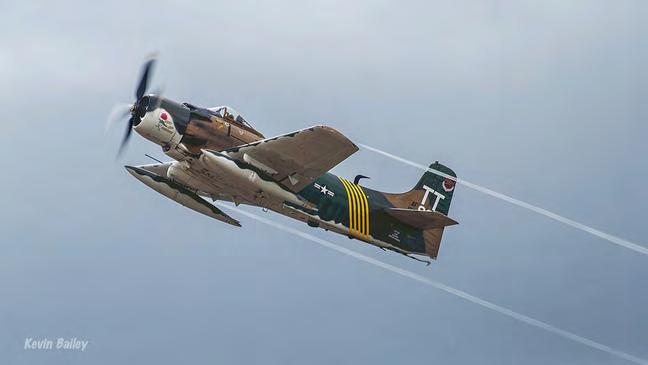
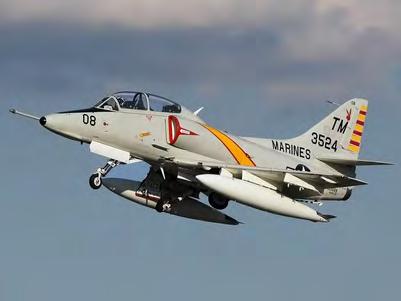


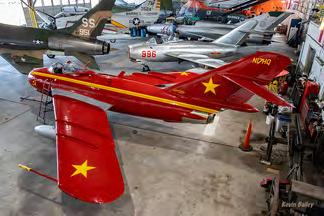





The National Business Aviation Association Business Aviation Convention & Exhibition (NBAA-BACE) supercharged an industry driven by strong growth and a blazing pace of innovation.
From a packed exhibit hall and standing-room-only crowds, to a dazzling NBAA Aircraft Connection and nearly nonstop announcements, the 2025 NBAA-BACE showcased an industry ready to take on the future.
Business aviation’s most powerful event, NBAA-BACE took place Oct. 14-16, 2025, at the Las Vegas Convention Center and Henderson Executive Airport (HND).
“From the moment we opened the doors, it was clear this NBAA-BACE would be a monumental gathering for our industry,” said NBAA President and CEO Ed Bolen. “With boundless energy and great vibes, this show captured all that is unique and exciting about business aviation.”
The 2025 show led off with an unforgettable performance by multiplatinum artist, pilot and aviation champion Dierks Bentley, who shared how his career in music-making has been interwoven with his love of aviation. On the keynote stage, Bolen presented aerospace visionary Steuart Walton with business aviation’s highest honor, NBAA’s Meritorious Service to Aviation Award.
A dizzying array of new technologies, never-before-seen aircraft and business ventures were unveiled at NBAA-BACE, including the world debut of Textron Aviation’s new Cessna Citation Ascend midsize jet and Otto Aerospace’s Phantom 3500 business jet, featuring advanced laminar-flow design.
Newly-formed company BOND chose NBAA-BACE for its launch as a fractional provider, announcing its large order of 50 Bombardier Challenger 3500 and Global 6500 jets. Real Jet, a business aviation brokerage firm, also made its rollout at the show.
Blockbuster deals and innovation milestones marked the convention from start to finish. Bombardier announced its Global 8000 had achieved a max operating speed of Mach 0.95, becoming the world’s fastest subsonic civil aircraft.
With an all-new format this year, the NBAA Aircraft Connection buzzed with the full diversity of high-tech business aircraft, from pistons to turboprops
and jets. Gulfstream exhibited nearly its entire line, with a mockup of the just-revealed G300 making its NBAABACE debut.
The new Tribute to Flight Pavilion hosted vintage airplanes from a Learjet 23 and World War II aircraft to the Jet Age alongside cutting-edge models, such as Game Aerospace’s aerobatic GB1 GameBird.
In the convention center’s entryway atrium, Archer Aviation showed off its electric vertical takeoff and landing (eVTOL) Midnight. Next to the futuristic eVTOL, the all-new NBAA-BACE Creator Studio, powered by Signature Aviation, provided a venue to connect with some of the most high-profile social media influencers and podcasters in business aviation.
On the show floor, Boom Supersonic, the startup developing a faster-thansound jet, exhibited at NBAA-BACE for the first time. Skyryse demoed its simplified flight control system to enhance safety and make aircraft easier to operate. Attendees had a chance to see uAvionix air traffic management systems for safely integrating advanced air mobility into the nation’s airspace.
At a timely newsmakers lunch on the show’s media day, Rep. Sam Graves (R-6-MO), Congress’ lead transportation policymaker, spoke about the urgent push in Washington to modernize the nation’s air traffic control system. Nick Daniels, president of the National Air Traffic Controllers Association (NATCA), spoke about the importance of the industry’s unified collaboration on safety leadership.
CNBC’s Phil LeBeau moderated a discussion with the CEOs of Bombardier, Embraer Executive Jets, Flexjet and Textron Aviation on business aviation’s future, the role of AI and ongoing workforce challenges.
NBAA-BACE provided countless opportunities to foster connection and promote new ideas.
The interactive NBAA Flight Deck hosted conversations with top leaders on the next generation of airspace, safety and the fast-moving business aviation market. In a year of intense focus on aviation safety, NBAA hosted the association’s latest National Safety Forum, NBAA Single-Pilot Safety Standdown and NBAA Small Operators Symposium.
The inaugural NBAA-BACE Military Connect presented a special program designed for veterans, by vet-
erans, for those exploring a civilian career in business aviation. Military Connect offered a full slate of sessions, networking opportunities, job search tools in the Career Zone and access to hundreds of potential employers.
At an overflowing and exuberant YoPro Networking Reception and Helpy Hour, the NBAA Young Professionals (YoPros) celebrated their annual hands-on community service project.
NBAA Collegiate Connect gave students a firsthand look at jobs in business aviation, with advice from industry pros at a range of career stages and tips for breaking into the industry.
At the show’s Awards Luncheon, NBAA’s 2025 Top 40 Under 40 were recognized, and Aviation Personnel International CEO Sheryl A. Barden,
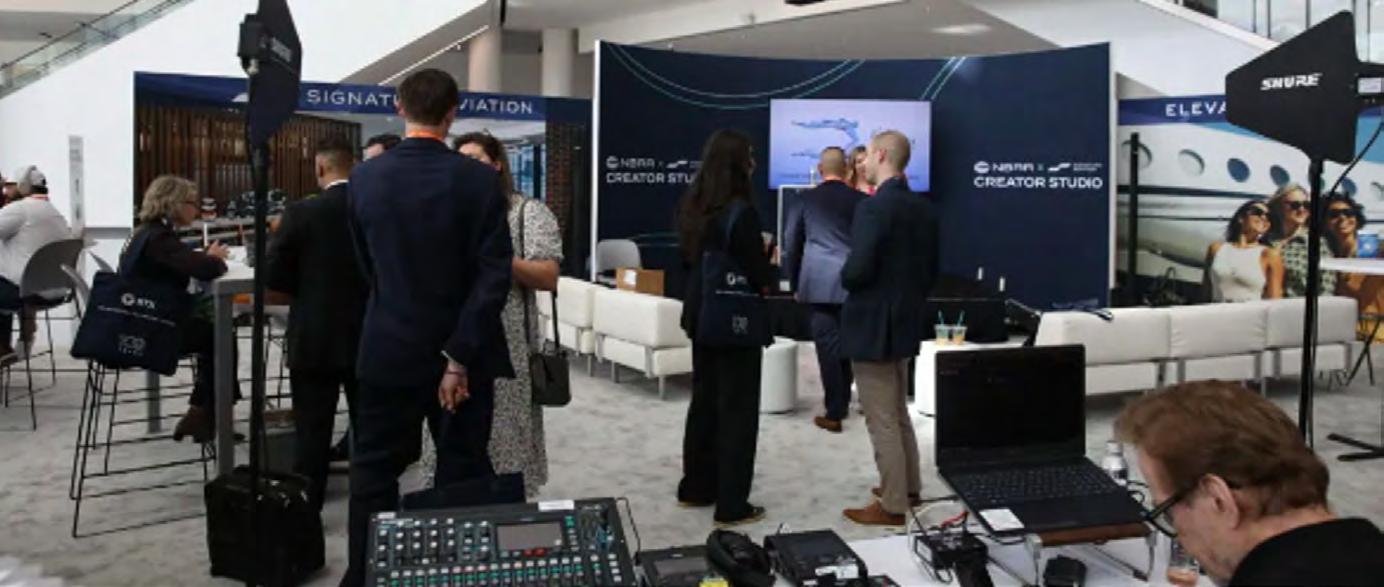


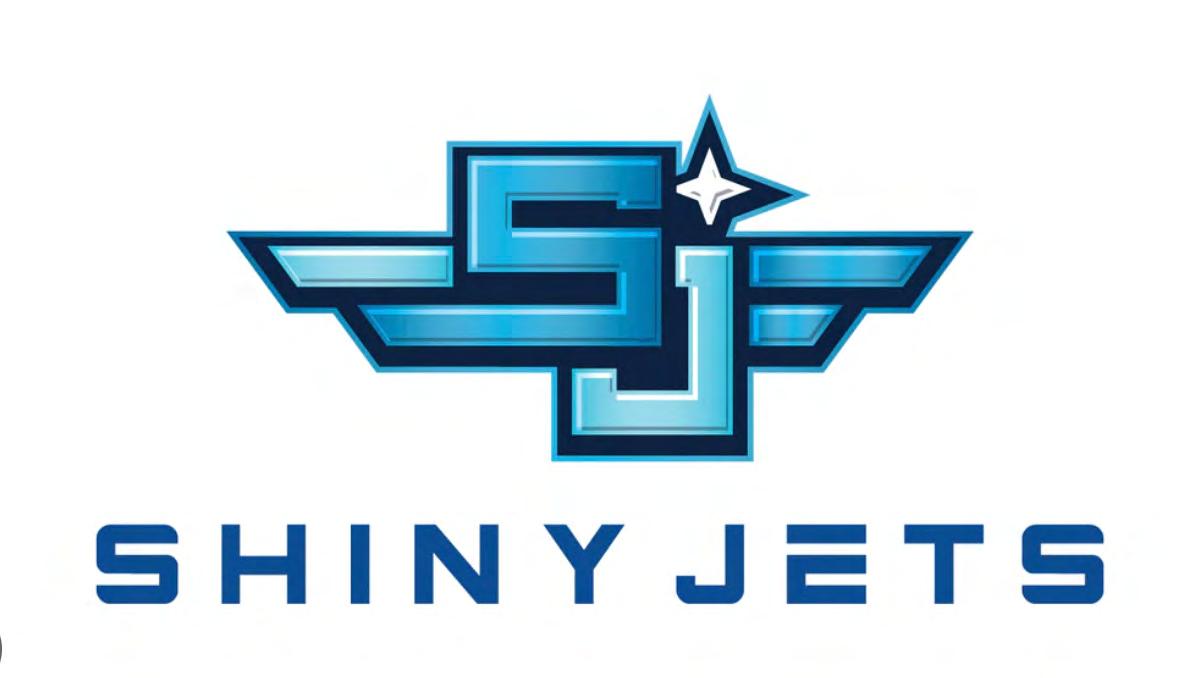
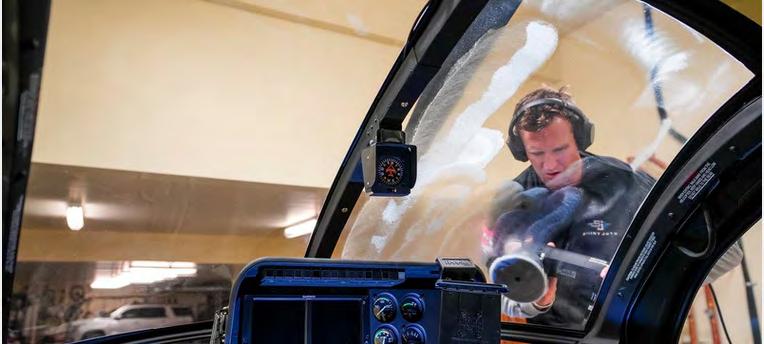




Continued from Page 19
the commercial airlines and the recreational aircraft. I’m happy to draw them, too. So, without people, without communication, without friendship and fellowship, I wouldn’t be drawing.
IFUSA PTG: You are more than just warbird stuff. Have you drawn houses or buildings?
BL: Yes, I have done cats, dogs, houses, and buildings. I’m also a portrait artist. I have a friend of mine, Gary Otto. He’s from Pewaukee, Wis. I drew a portrait of him to honor him because
Continued from Page 10
I found myself teaching evening ground school. All was good, with my students (flight and ground) probably teaching me more than I taught them! One student in this class was a well-dressed and pleasant chap who was working on his Commercial certificate. At least twice my age and apparently successful, he owned an unusual Twin Navion, a single-engine plane converted into a twin. Not having a multi-engine rating at that time, I eagerly accepted an invitation to join this fellow for dinner at a popular local airport, offering to let me fly his plane.
Frankly, this writer was willing to fly just about anything in order to build experience and time, overriding what should have been a common sense “red flag” regarding the combination of flying with an unknown person in an unfamiliar airplane. I did point out that our dinner destination had a short runway and that we would be returning at night… did he feel comfortable with this? This commercial wannabe assured me he had been there before, and all was good. Upon departing, my left-seat buddy had difficulty with tower communication and could not answer some simple questions I asked about the plane regarding systems operation. An uneventful flight (giving me a chance to play with this unusual plane) was followed by the owner making a sloppy entry into the traffic pattern, perhaps caused by nearby terrain that forced a close-in downwind leg. Turning final, I became concerned that we were very high, finally offering a comment to the left-seater, who said “not to worry, nor-
he was a very, very important friend in my life. He’s an influential friend in my life. One of the kindest gentlemen I ever met. He earned the Wright Brothers award for flying 50 years in an aircraft. Fifty years of flight. I gave him a special hand-drawn 16-inch by 20-inch portrait of him flying in a T-34 based off of a selfie that he took. I’ll just throw the joke in here. The ongoing joke about the selfie was that I kidded with Gary because he took too many selfies. I said to Gary, “What’s the matter? Did you take one too many selfies with the
wrong guy looking at him?” So, he’s got a beautiful portrait. I framed it for him. I put a name placard on it. I mean I can do portraits; I can draw just about anything as long as it’s got a shape and it exists. If there is some kind of fantasy out there, you’d have to help me envision.
IFUSA PTG: You are working on a new website to show off your artwork, correct?
BL: To that point, I am actually still in college at the University of Wisconsin, Green Bay and finishing my Studio Arts Bachelor’s degree and simultane-
ously working on my website with the domain of BrianLiddleArt.com; in the interim, I can be reached at (920) 6347034 / liddle.brian@yahoo.com / Brian Liddle on facebook. Thank you for this opportunity to talk more about myself to the In Flight USA readers.
IFUSA PTG: Brian, thank you for the most informative overview of your background, artwork, desires, and a peek into your flourishing artistic career. Folks, I highly recommend looking into Brian’s exquisitely detailed artwork.
mal for this plane.” Going to idle power in order to get down to the runway (very short) we hit a rate of decent approaching 1,500 FPM. Instinct finally kicked in, and this young aviator realized we would not be able to flare out of the dive and still land in the distance available. Just prior to impact, having waited too long, I yelled “I HAVE THE PLANE,” and aggressively flared. We hit the ground hard, nose wheel first and ricocheted back onto the main gear, launching us back into the air. Immediately seeing that the nose gear “green” light had extinguished, I jammed the throttles full forward and augured back into the air.
A quick glance at the owner found him sitting quietly, staring straight ahead, as if nothing had happened. Yes, this was a lesson in human factors as well as airmanship… something was wrong with this guy! The next hour was spent digging through seat pockets to find a flight manual, employing emergency gear extension procedures while pulling “G’s” and finally getting a mechanical down-lock to give me a nose gear green light. Even the VHF radio had failed, requiring the use of an old LF radio to contact my home tower for a flyby and gear check with a spotlight, as the sun had set. Having once flown a Piper Apache, I used the Apache numbers for approach and landing. The owner remained nearly comatose as we taxied in, saying nothing but “have a nice evening” after we reached the tiedown spot. I was left standing on the ramp, frankly, quite shaken up, thankful that this oddball Navion had taken care of me.
I visited the FAA General Aviation

District Office (GADO, the predecessor of today’s FSDO) and chatted with friends about the event. Long before the days of computers, my FAA pal decided to look into the plane’s ownership and the pilot I had flown with. Later that day, the maintenance manager caught me between students and invited me to look at the Twin Navion, now up on jacks. The entire nose gear structure was badly damaged and forward fuselage skin wrinkled. I had literally flown away from a crash! The “owner?” was never seen again and the FAA had no records with his name. The registered owner of the plane was not the guy with whom I had flown. The only thing “real” about that flight was this writer’s poor judgment in combining a strange plane with an unknown pilot and then allowing obviously poor airmanship to continue to the point of near disaster. The important lesson learned, and employed many times since, was… act
when your “gut” tells you to act! This writer’s resolve to step in when needed has served me well over the years. Litigation often holds a CFI who has access to the controls of a plane as bearing some responsibility when accidents or FAR violations take place, even if not the “legal” PIC. There is a general expectation that a senior pilot is derelict in their responsibilities if they allow obviously poor piloting or lack of regulatory compliance to continue when they could have interceded. This writer has developed a standard briefing, in which I explain the complexities of PIC status with a CFI having access to the controls, offering to function as a co-pilot if the PIC chooses to use my skills. The briefing is done as if asking the PIC to do me a favor, by recognizing the legal challenges I face and to understand if I suggest or offer to assist
Continued from Page 34
in flying the plane. Typically, I remain as a passenger, but unexpected events can happen.
While flying with a family friend in a newly acquired Cessna 340, the PIC ended up very low on an approach to a
high-altitude airport, perhaps confused by the higher than normal groundspeed at high density altitudes. This CFI stepped in and assisted with the approach. Once, while flying with another CFI and our wives for a pleasure flight, the left-seat CFI attempted to suddenly abort the takeoff due to what
turned out to be a full-on pitot/static failure. Distracted by weird instrument indications, my friend suddenly pulled the power back, apparently not realizing we were nearly 50 feet in the air. Things got pretty busy for me! How about the aircraft salesman who, while demonstrating a used single to me and

the prospective purchaser, wanted to make an instrument approach by simply letting down through a cloud layer over the ocean and then proceed to the airport in minimum VFR. Not with this CFI on board! As an airline executive, I traveled frequently between Los Angeles and Washington D.C., often as a crewmember or riding jump seat. On one jump-seat flight, while descending into Los Angeles, the newly hired flight engineer allowed the cabin to depressurize at about 15,000 feet. The old B-727 pneumatic outflow valves started popping open and closed, creating a very uncomfortable experience for all aboard. I quickly offered to take over the FE station, suggested a short level-off so that I could regain pressurization control. The crew responded as a team (I am a certified Flight Engineer) and all ended well, with this writer simply taking the plane to the gate and the new hire getting needed instruction. In thinking back to the aforementioned events, it is surprising to realize that many of the times this writer was required to take immediate action were when flying as a passenger, not PIC. While the preceding remembrances are specific to issues faced by CFI’s, is there something to be learned that applies to all pilots? Do not let concerns that you might embarrass a friend or harm a professional relationship slow down your willingness to step in when needed. Do not go flying with another person simply because they invite you to. It is not unreasonable to determine if they are current and have needed endorsements. Ask yourself… how do you feel about the airplane you are about to enter? Does your circle of flying friends include the “story-telling braggart” who makes claims of skill and daring that you know to be untrue? Chat with your local CFI to see if that person can be counseled.
This writer has worked with FSDO (through the FAA FAST Team) to conduct an “intervention” on several occasions. When concerned about hurting someone’s feelings, this writer politely explains that I am concerned about safety and litigation, as even the family of a deceased CFI (flying as a passenger) may be litigated against if the deceased CFI can, in some way, be found to have been able to mitigate the event. The bottom line is that every pilot is PIC the moment you enter a plane and have access to the controls. Develop that mindset, and adventures such as those experienced by this old CFI can be avoided.
NBAA President and CEO Ed Bolen took the keynote stage on opening day of the 2025 NBAA Business Aviation Convention & Exhibition (NBAABACE) for “an absolute celebration of business aviation” and its role not only in driving economic growth and technological innovation, but also in inspiring future generations to aim higher.
“We’re a vital link in the global transportation system,” Bolen said. “We create jobs. We help companies be efficient and productive in an intensely competitive global marketplace. We provide humanitarian assistance to those in need, and we are on a mission to net-zero. It is great to be part of a great industry.”
Bolen emphasized that safety also remains of paramount importance not only in the business aviation community but throughout all other industry sectors following a series of high profile, fatal accidents earlier this year.
“We saw the entire aviation community coming together on the plan to build
a brand-new air traffic control system,” Bolen said. “Airlines, airports, labor, all of general aviation [and] alignment between the president, the secretary of transportation, both houses of Congress and a public demanding that we build a new ATC system.”
Bolen also recognized in the audience the two most recent enshrinees to the National Aviation Hall of Fame, aviation safety consultant and former NTSB member John Goglia and NBAA Chair Emeritus Gen. Lloyd “Fig” Newton. “We’ve gotten to our point today by standing on the shoulders of giants,” he said.
Steuart Walton: Aviation is a Tool to ‘Connect, Meet and See What’s Going On’
Aviator, entrepreneur and business leader Steuart Walton then joined Bolen to receive NBAA’s Meritorious Service to Aviation Award, the association’s highest honor.
In addition to serving as a director
for Walmart, Walton is the co-founder and chairman of Game Aerospace and a prominent leader in fostering the development of advanced air mobility (AAM) aircraft. He also restores and flies a variety of vintage aircraft, some of which are on display during NBAABACE at the NBAA Aircraft Connection at Henderson Executive Airport (HND).
Those aircraft, along with Walton’s work to make Thaden Field (VBT) in Bentonville, AR, a hub of community activities both related to aviation and not, serve an important purpose in his life.
“Aviation is just an absolutely unparalleled platform for inspiration to young folks, or people looking for the opportunity to find a new career,” said Walton. “The more you can tell that story about what aviation is and what it can be, you open people’s eyes to it. And the more people that come into it, the stronger it gets.”
Business aviation has also played a

vital part in Walmart’s growth, from the early days when Steuart’s grandfather, Sam Walton, flew a two-seat Ercoupe to visit stores, to now operating one of the largest business aircraft fleets in the world.
Continued on Page 38





The Aircraft Owners and Pilots Association (AOPA) is offering its electronic Flight Instructor Refresher Course (eFIRC) free to AOPA members who were affected by the apparent closure of AceCFI. (As of Monday, Oct. 27 – In Flight USA’ s press deadline –the AceCFI website was not available.)
The FAA approval of AceCFI’s FIRC expired on Sept. 30, 2025.
“Within hours, AOPA started hearing from many AceCFI customers. For many, this happened right in the middle of their renewal, which is tough — and depending on how close you are to your
expiration date, incredibly stressful,” said AOPA FIRC Program Manager Mary Kuehn.
“The proceeds from this course typically fund the AOPA Air Safety Institute’s pilot education and safety initiatives but given how disruptive this has been to many instructors, offering the eFIRC to our affected members at absolutely no cost was an easy decision,” said AOPA President and CEO Darren Pleasance. “By becoming a member, you directly support the future of general aviation through our advocacy efforts across the country, you get access
to renowned aviation experts and medical specialists, and you receive the most widely circulated aviation magazine in the world, AOPA Pilot.”
As announced in mid-October, on Nov. 1, AOPA’s eFIRC will be released with major updates, including an entire module dedicated to helping flight instructors understand the recent and upcoming changes from MOSAIC.
“AOPA is uniquely positioned to offer the most robust, up-to-date course for flight instructors,” said Kuehn. “In addition to revamping the entire course every two years, we also update it any-
time a new law or regulation affecting flight instruction goes into effect. We work with AOPA’s government affairs team to understand it and AOPA’s Pilot Information Center to get insight into the questions instructors across the country have, which helps us constantly improve our eFIRC to meet instructors’ needs.”
To take advantage of the offer to former AceCFI customers, AOPA members can reach out to Member Services at (800) 872-2672 or memberservices@aopa.org.

Continued from Page 36
“I’ve had a number of conversations with people who [thought] for so long, my business was sort of doing this” – Walton’s arm mimed a gentle upward slope – “and when I bought an airplane, all of a sudden my business started doing this,” angling his hand sharply upward.
“The ability to connect, meet and see what’s going on is very hard to assess or model, but it’s very great in our experience,” he added. “It’s just an enormously important aspect, not only to Walmart, but to the United States in general.”
Dierks Bentley Riffs and Rocks in Support of Business Aviation
Bolen then welcomed to the stage multiplatinum artist, accomplished pilot and aviation champion Dierks Bentley, who marked his return to NBAA-BACE 10 years after he gave an impassioned, off-the-cuff presentation about the importance of aviation to his career.
A few things have changed for


Bentley since then, including moving from his earlier Cirrus SR22 to first a Textron Aviation Cessna Citation M2, and then a larger and speedier Citation CJ4. “There’s a great scientific mathematical equation that discusses the perfect number of Martin Guitars to own: ‘N plus one,’” Bentley said. “The one you have plus one more. And that relates pretty well in aviation, too.”
Continued from Page 30
ing demands consume substantial time and resources, diverting personnel away from hands-on maintenance activities. While these tasks are intended to ensure regulatory compliance, industry representatives have noted that the added burden provides minimal direct improvement to operational safety.
Striking the Right Balance Regulations are essential for ensuring aviation safety; they set the standards that prevent accidents and maintain public trust. At the same time, overly rigid application can create inefficiencies and divert resources from hands-on maintenance. A balanced, risk-based approach allows the industry to comply fully with regulations while applying them thoughtfully. Skilled technicians and engineers can exercise professional judgment, inspections can focus on the most critical systems, and documentation can be simplified without losing traceability. Regulations should also be reviewed regularly to remove outdated or redundant requirements. By following this approach, aviation organizations maintain high safety standards, ensure regulatory compliance, and use resources efficiently.
Conclusion Regulations are essential for ensuring safety in aviation maintenance, but over-regulation can create inefficiencies, increase costs, and reduce operational flexibility. By adopting a balanced, risk-based approach within a strong regulatory framework, the industry can maintain the highest safety standards, improve efficiency, and remain adaptable to future challenges and technological advancements, ensuring continued progress and public trust.
References
1. Federal Aviation Administration. (2017). Advisory Circular AC 12017B: Aircraft Maintenance Management, https://www.faa.gov/documentLibrary/media/Advisory_Circular/ AC_120-17B.pdf
2. European Union Aviation Safety Agency (EASA). (2019). Commission Regulation (EU) 2019/1378: Part-145, https://www.easa.europa.eu/document-library/regulations
3. Aeronautical Repair Station Association (ARSA). (2020). Application burden, https://arsa.org/application-burden/
4. Wikipedia contributors. (2025).
Flying also helps Bentley maintain perspective on the challenges of managing his life and career. “One day I told my 7-year-old daughter I ‘got to’ go try to write a song,” he said. “She looked at me with this kind of quizzical look on her face, and she said, ‘You got to, or you get to?’ Now, this was not a usual conversation for us to have, about perspective and gratitude. But I
told her, ‘You’re right, I get to go write songs.’”
Flying, Bentley continued, is always a ‘get to’ in his life, whether it’s in the left seat as PIC or “mangling my radio calls” as second in command to his friend and professional pilot, Buck. “Or I can go sit in the back with the guys in the band and play cards,” he added.
“There’s just so much laughter, talking and fellowship happening in the back of that plane. It’s the first time I’d ever had FOMO in an airplane, because I’ve always thought being a pilot is the coolest thing of all time,” he said.
Bentley closed his presentation with a performance of his hit single “Riser” (“it’s about just being there for your friends when they’re down. And in this aviation community you’ve always got a lot of buddies to lean on”) followed by a few bars of another hit, “Drunk on a Plane.”
“I know Ed doesn’t like that one as much,” he quipped. “But a key line in the song is, ‘Buyin’ drinks for everybody but the pilot.”
Reliability-centered maintenance. In Wikipedia, https://en.wikipedia.org/ wiki/Reliability-centered_maintenance
5. Wikipedia contributors. (2025). Maintenance resource management. In Wikipedia, https://en.wikipedia.org/ wiki/Maintenance_resource_management
6. Cato Institute. (2020). The Risk of Too Much Air Safety Regulation, https://www.cato.org/regulation/ spring-2020/risk-too-much-air-safetyregulation
7. SAS Sofia. (2024). The Limited Effectiveness of Regulations and Procedures in Aircraft Maintenance, https://www.sas-sofia.com/aviation-regulations-effectiveness
8. Aviation Week. (2022). Mechanic Safety Has Improved, But Significant Risks Remain, https://aviationweek.com/mro/safety-ops-regulation/ mechanic-safety-has-improved-significant-risks-remain
9. ScienceDirect. (2024). Safety Management System and Risk-Based Approach in Aviation Maintenance, https://www.sciencedirect.com/science/article/pii/S092575352400345X
10. Federal Aviation Administration. (2013). FAA Repair Station
Oversight, https://www.oig.dot.gov/ sites/default/files/FAA%20Repair%20 Station%20Oversight%5E5-1-13.pdf
11. AOPA. (2024). Aircraft Maintenance: New FAA Interpretation Could Devastate GA, https:// www.aopa.org/news-and-media/ all-news/2024/october/01/aircraft-maintenance-new-faa-interpretation-could-devastate-ga
12.MDPI. (2024). Winging It: Key Issues and Perceptions around Regulation in Aviation Maintenance, https:// www.mdpi.com/2226-4310/7/6/84
13.Flightline Weekly. (2024). Navigating Over-Regulation’s Impact on Aviation Safety, https://www.flightlineweekly.com/post/the-delicate-balance-navigating-over-regulation-s-impact-on-aviation-safety
14. Tandfonline. (2009). A Performance Improvement Case Study in Aircraft Maintenance and Repair, from https://www.tandfonline.com/doi/ full/10.1080/00140130903194138
15. MATEC Web of Conferences. (2020). Safety Differently: A Case Study in an Aviation Maintenance-Repair Organization, https://www. matec-conferences.org/articles/matecconf/pdf/2020/10/matecconf_icsc-isatech20_01002.pdf

By Darren Pleasance, AOPA President and CEO
Since taking office in January, I have been in many remarkable places. Recently, I found myself in a golf cart at Ohio’s Akron Fulton International Airport (AKR) with a member of the city’s chamber of commerce during the Props and Pistons Festival. While I often find myself preaching to the choir — you, our members — about the value of airports, here I found a willing and receptive audience. This energetic city employee had no idea about the value of his airport, and it was a thrill to tell him. His amazement and how he absorbed my passionate sermon got me thinking about how we all can — and should — preach to others about the importance of small airports.
The Akron airport is like most of the 5,000-plus public-use airports that serve general aviation throughout this country. Its single, paved 6,330-foot-long runway serves nearly 50,000 aircraft operations each year. It has a rich history, starting as a U.S. naval air station in 1929, and is home to the Goodyear Airdock where the first lighter-than-air ships and the famous Corsairs were built. It has an active FBO in Summit Air, which offers fuel
and hangar rental to local and transient pilots. It has a maintenance facility to service a wide spectrum of aircraft, and it is home to 84-based aircraft. This description could apply to nearly any GA airport in this country, and that’s what I told my rapt passenger during our golf cart tour. An airport like AKR serves and benefits so much of the pilot community.
But I also wanted to make sure he understood what else this airport does for the nonflying community. I told him of the mechanics and line personnel there who put food on their table with the wages they earn, and of the young instructors grooming the next generation of pilots, many of whom go on to be airline pilots (he believed most airline pilots come out of the military — not anymore!). I explained the community services such as the police and fire departments that rely on the services of the Akron airport (his face lit up when I said that, telling me enthusiastically that, yes, the Akron police department had a helicopter based there); and that businesses surrounding the airport were built there because proximity to an airport allows company managers from headquarters to easily visit by flying into Akron directly. He told me he
Continued from Page 25
congestion. It is commonly known that Southern California can be a particularly busy place for business and travel, leading to congested air traffic. The Santa Monica Airport, although small, plays an important role in helping alleviate some of that congestion. They are able to incorporate private and charter planes, which help ease traffic in the major area, including Los Angeles International Airport (LAX).
Although the business advantages and reliever impacts are very important to the aviation community (and the community at large for that matter), unfortunately, the Santa Monica Airport is no longer deemed economically viable, according to city officials. While much of their decision to close the airport stems from a 2011 study that indicates approximately $275 million in annual economic output and support of 1,475 jobs (but only 178 direct aviation jobs), the City Manager advised city officials that much of that output cannot be tied directly to aviation uses and that the airport itself “was actually a loss” for the City’s general fund for years.
According to Santa Monica city officials, the high land value, consisting of approximately 200 acres, can give the
city of Santa Monica more opportunities that can provide more significant financial growth and economic viability. They arrive at this conclusion by stating that the land was historically acquired and operated under aviation terms, resulting in constraints and costs for maintenance, regulatory compliance, environmental issues, and infrastructure expenses. Essentially, most output is restricted for aviation/airport usage and thus is not seen as beneficial to the city’s general fund by city officials.
The City is engaged in a process to determine a “preferred alternative” for the airport that would be more economically feasible. So far, they are looking at a large public park or a mixed use of a park and housing that could yield higher revenue streams, less operating costs and an increased tax based that would benefit the city. The small businesses at the airport would be converted to commercial tenants, if the buildings were to remain and the aviation businesses theoretically forced to leave.
Meanwhile, the airport continues to host events, which have the opportunity to bring in temporary staff members to businesses, volunteers and the general public, leading to more opportunities for
hadn’t realized there was so much going on “behind the airport fence.” And since I was on a roll, I continued with more examples of great things happening at airports, including humanitarian flights from volunteer pilot organizations such as Angel Flight, Veterans Airlift Command, and Pilots N Paws; trade schools on airports training the next generation of mechanics (we need more than 400,000 mechanics over the next decade); and disaster-relief flights from volunteer pilots following wildfires, floods, hurricanes, and other natural disasters. He was suitably overwhelmed by the contributions just one small airport provides to its local community.
My narrative took me back to another encounter where the lack of understanding for small airports caught my attention. Shortly after taking my new role at AOPA, I was in Bend, Oregon, speaking with the airport manager about airport economics. I was advocating to invest in things that drive airport activity and stronger airport economics, like compatible use development (e.g., light manufacturing), hangars, flight schools, maintenance operations, fuel flowage fees, even restaurants. In my view, the city should be investing in the
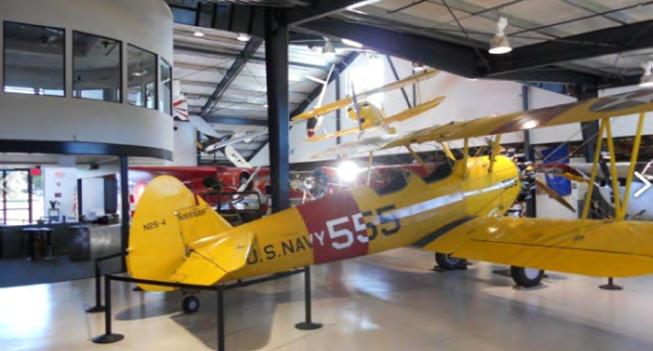
work and business and for the community to learn about flying and the contributions made by the airport to the community.
The Santa Monica Airport handles approximately 60,000 operations annually.
The airport will continue to operate through Dec. 31, 2028. JSX’s proposal can continue to operate along with other aviation businesses and activities. The airport will continue to ensure compliance with the Consent Decree, which means keeping the runway to 3,500 feet (which it shortened in 2017 from 4,973 feet and resulted in a loss of operations) and limiting jet operations and reducing noise and air pollution. The decree ended a long legal battle that spanned more than 30 years where the FAA argued that SMO
airport so it delivers the most value it can to the community. However, the airport manager shared that she was largely on her own to “make the airport work” and that city leaders believed the airport was a playground for the rich to play with their “toys.” In hearing this, a light went off, and I understood. It is about perception, knowledge, and understanding. Once people are affected by an airport — their child needs a medical transport that an Angel Flight volunteer pilot provides, or a person’s home is saved by an aerial firefighter, or their neighbor’s young daughter ends up being the pilot on their airline flight home from vacation, or a hurricane-ravaged community receives much-needed supplies — they get it. We all need to educate the public on the value of our airports. We are so fortunate in this country to have the airport support system we have. It makes our country richer and more vibrant. We, as pilots and users of the system, know this. Time to spread the word. Will you join me?
AOPA President and CEO Darren Pleasance is a CFI and has flown more than 8,000 hours in more than 80 different aircraft.
had to remain open “in perpetuity,” while the city wanted local control and eventual closure.
So for the next three years, while SMO remains open, please consider showing your support to the Santa Monica Airport and making the most of this time to educate yourself on important historical aviation events, locations and lessons.
The Museum of Flying is located within the Santa Monica Airport. Douglas Aircraft is the primary focus of the airport museum, offering insightful information and education. The museum is located at 3100 Airport Ave., and was originally founded in 1974 as the Douglas Museum and Library. Along with the Douglas Aircraft Company, the museum has a strong focus on the history of aviation. The museum is an interesting place and patrons should definitely check out all it has to offer. Some exciting exhibits include, the Beech Staggerwing, a Cessna L-19 “Bird Dog,” a Boeing Stearman, and many other interesting aircraft that have strongly impacted aviation history. While this is a difficult situation for the Santa Monica Airport, it is important to continue to value and show support for this important airport.
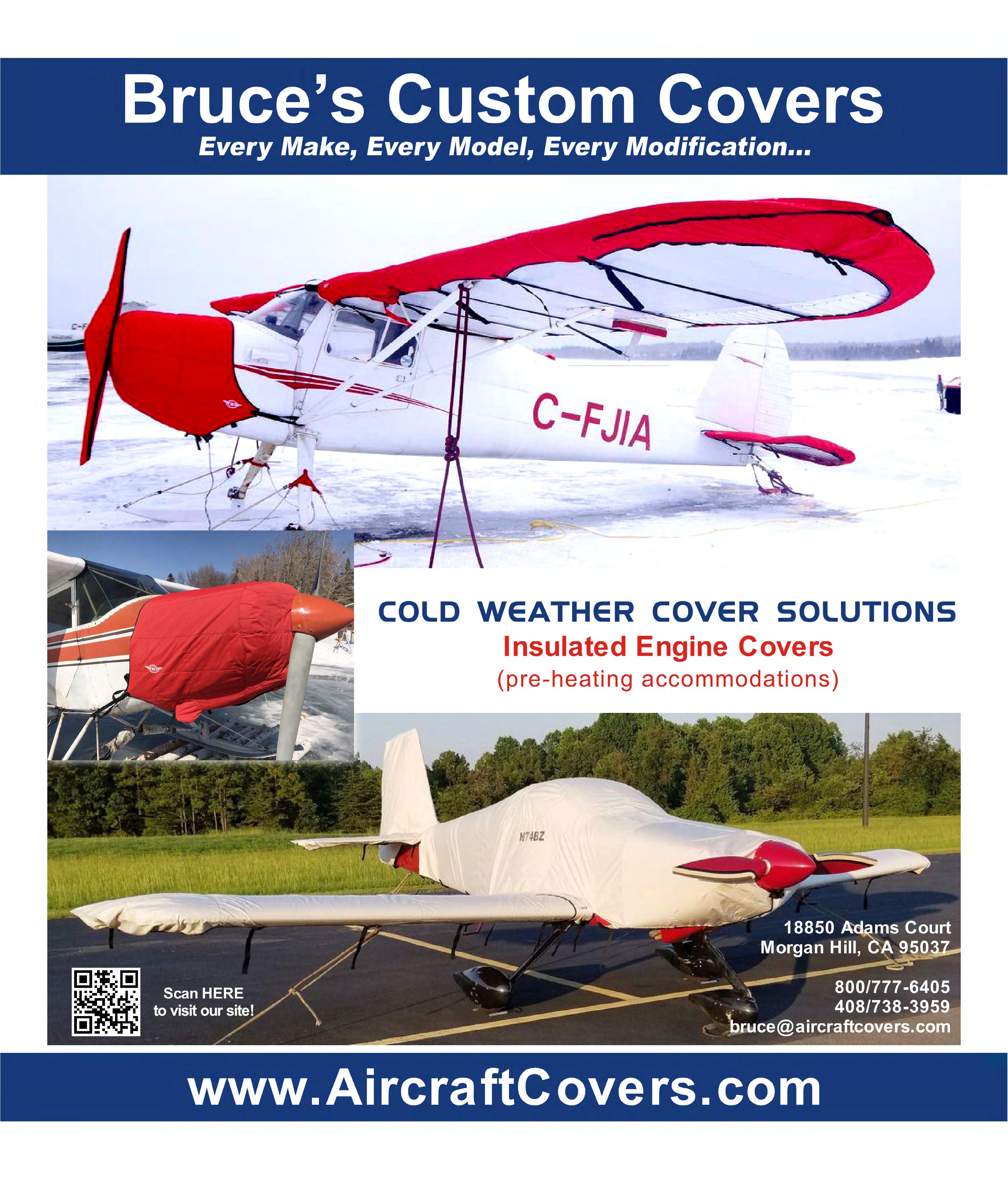
Continued from Page 11
expense, and possible chemical spills and fires.
Additional Strategies and the Benefits of Going Green
There is a wide variety of additional green solutions for aviation businesses that are worth looking into:
• Optimizing runway and ramp design to minimize taxiing times
• Investing in green building and infrastructure upgrades, including more efficient water, HVAC, and waste and recycling systems
• Partnering with a provider of Sustainable Aviation Fuel (SAF)
• Mitigating wastewater and stormwater runoff
• Participate in green aviation campaigns and certification programs like the FAA’s Airport Sustainability Program, ACI’s Green Airport Recognition awards, Airport Carbon Accreditation, and local governmental
utility efficiency initiatives.
As for the benefits of pursuing sustainability and conservation – creating a cleaner, greener workplace for employees and customers and contributing to a healthier planet for all of us is its own reward.
It’s also a practical financial decision. Transitioning to LED lighting alone slashes energy use up to 75 percent and requires significantly less maintenance. Incorporating solar power, investing in electric GSE, and other efficiency-promoting conservation efforts yield similar economic benefits. Then there are the government grants, subsidies, tax benefits and other incentives that reward increasing efficiency and adopting sustainable, renewable practices.
Finally, in addition to a likely lowering of insurance costs, investing in the future by going green is excellent PR and positive exposure for any airport or FBO.
About the Author
Frank McGovern is lucky enough to live in beautiful Boise, Idaho where he works as a Web Product/Content Manager for internationally renowned GSE manufacturer and distributor, AERO
Specialties. When not reading, writing, and seeking adventure with his fiancée and their blended dog family, he enjoys the world-class outdoor opportunities Idaho has to offer.

Beach Airport (view of the concourse) in Southern California is known for keeping sustainability in mind, with eco-friendly standards in place for everything from major developments to smaller pavement projects and even mulching. LGB also boasts a commercial food scrap recycling program.
courtesy Long Beach Airport)
By Luis Hoffman, Global Licensing Director (Sustainable Fuels) at Sulzer
Very few people want to give up flying. It’s how we stay connected with family, expand business opportunities and take holidays to relax. This makes scaling the production of sustainable aviation fuel (SAF) – along with other technology developments such as battery-powered planes – critical if we want to continue flying while trying to stop climate change. Without it, we risk significantly reducing, or even losing, our freedom to connect. First-generation biodiesel (Fatty Acid Methyl Ester or FAME) producers who have the feedstock, capability and resources to switch to SAF production may hold the fate of air travel in their hands.
Although SAF currently represents less than one percent of the overall jet fuel market, several countries including Japan, South Korea, Malaysia, Turkey and Brazil will introduce SAF mandates from 2026 or 2027. This will add to existing commitments from the UK and European Union. Meanwhile, several more countries are considering the introduction of SAF targets in the coming years. With growing global demand, supportive policy regimes, and a significantly
underserved market, now is the time for biodiesel producers to make the switch before feedstocks become difficult to secure.
With global SAF demand expected to rise 10-fold from 2024 to 2030, supply pressure on feedstock is already becoming apparent. For example, in late 2024, the Intercontinental Exchange launched a dedicated used cooking oil futures contract in response to rising demand, creating the opportunity for participants to better manage their price exposure.
Securing long-term feedstock contracts
When considering an investment in the construction of a SAF plant, one of the major constraints is the availability of feedstock on a long-term supply contract. Consequentially, existing biodiesel producers with contracts already in place that can be diverted to make SAF instead of biodiesel start from a place of advantage.
This need for long-term contracts is further underscored by the changes we can expect to see in feedstock import and export volumes. Around 90 percent of the UK’s SAF is currently produced using imported cooking oil from China. However, with China’s plans to introduce its own SAF targets, some producers will need to begin sourcing alternate feedstock closer to home. Altogether, having
feedstock contracts locked in early on in project development is essential for managing risk and optimizing project returns. Financial incentives are set to expand
One of the key benefits of moving from biodiesel to SAF production within the next couple of years are the attractive financial incentives currently on offer, particularly in the U.S. market. On top of the RIN credits that both biodiesel and SAF collect through the U.S. Renewable Fuel Standard, SAF also attracts up to $1 /gallon credit through the 45Z Clean Fuel Credits scheme. State credits can also pay up to an additional $1-2/gallon for SAF. This brings total incentives for SAF to up to $3.5/gallon more than biodiesel.
While in Europe, there are no dedicated financial incentives, yet changes on the near horizon look promising. For example, there is a proposal to introduce a stronger price signal for SAF production through the Energy Taxation Directive, which would provide a tax exemption. The European Commission is also expected to release a Sustainable Transport Investment Plan later this year, in which industry bodies such as ACI Europe have called upon to allocate specific EU funds to develop SAF production facilities.
Although SAF plants are currently more expensive to build than an equiv-
alent capacity biodiesel plant, incentive regimes along with the premium price levied on SAF make for attractive project returns. For most U.S. projects, the typical payback period has fallen to under three years, creating a compelling case for investment.
Technology choice has a significant impact on project economics
For those biodiesel producers interested in converting their facilities, a preliminary techno-economic assessment will estimate the cost of construction, the volume of SAF that will be produced, operational costs such as utilities and financial incentives available. Reusing auxiliary existing infrastructure from the biodiesel plant such as housing, pretreatment systems, and tankage, can reduce product costs by 20-30 percent.
Currently, eight technology pathways exist to manufacture SAF, but the HEFA pathway i.e. hydrotreating fats, oils and greases offers the industry’s fastest payback and lowest total cost of production while producing comparable yields. This is made possible by the latest innovations, which move away from traditional trickle-bed design, as well as opting for a modular build.
For example, Sulzer’s BioFlux technology is a two-stage liquid full hydro-
Continued on Page 43
Continued from Page 42
treating process that first removes the oxygen from the oil and then isomerizes it so that the hydrocarbons resemble jet fuel. Rather than using a conventional trickle bed reactor design, which is prone to hot spots, BioFlux uses a liquid full reactor design where the catalyst bed is completely submerged in liquid feed with hydrogen dissolved using a proprietary internals design, leading to homogeneous mixing. This significantly improves the efficiency and efficacy of the reaction, optimizes the volume of hydrogen needed and extends the life of the catalyst. In addition, the process has less equipment, so it is simpler to maintain and more reliable. For example, the traditional method requires gas compressors for recycling the vapor; instead, BioFlux eliminates the vapor recycle loop and gas compressors and uses pumps to move the effluent.
Modular construction is paving the way for smaller plants
The use of modular design is also transforming construction costs particularly for plants with capacities up to 200,000 kTa. For SAF production technologies that use less equipment, modular skids are a practical option that simplify integration, reducing time to market to within two years. These smaller plants are expected to become much more common, decentralizing production and
bringing feedstock supply, production, and offtake closer together.
For example, with several airline carriers in the APAC region now buying SAF, Thailand-based Energy Absolute who is also a first-generation biodiesel producer has invested in a new plant in Rayong, which will use cooking oil and palm fatty acid to make about 15 million gallons of SAF a year. The plant has been designed so that it can seamlessly switch from SAF to winter-grade renewable diesel to meet local market demands.
When combining the latest innovations in SAF production with modular design, SAF producers can expect to reduce CAPEX by 20-30 percent while benefiting from an ongoing saving of between 10-20 percent in OPEX costs. Whereas producers that opt for older technologies and traditional plant design will find themselves with a more complex and expensive plant to operate, slimmer margins and longer payback periods.
For biodiesel producers, the window of opportunity to transition into SAF is open. With demand accelerating and policy momentum building, biodiesel producers making the switch now will not only corner the market for themselves but pave the way for the success of SAF into the future. Those that wait risk less favorable economics and considerable competition for feedstock.
Continued from Page 32
CAM, received a standing ovation when presented with the John P. “Jack” Doswell Award, which honors lifelong achievement and service to business aviation.
In total, there were more than 75 education sessions at NBAA-BACE on hot topics, from the latest thinking about leadership, maintenance, operations, regulations and more.
Before and after the show, NBAABACE offered five Professional Development Program (PDP) courses to help people in the industry level-up their careers. The show also held its inaugural “Maintenance Track,” which allowed participants to qualify for up to eight hours of inspection authorization (IA) renewal credit.
The 2025 NBAA Tax, Regulatory and Risk Management Conference gave a timely look at aircraft transactions in a shifting tax-and-tariff environment.
The Business Aviation Sustainabili-


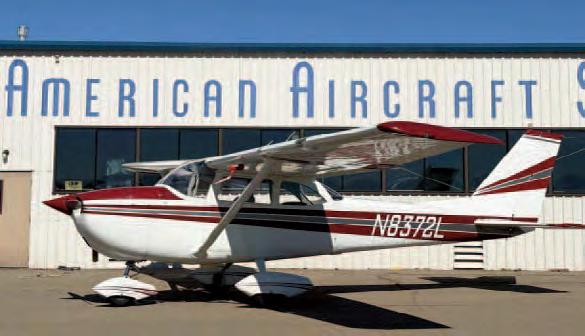
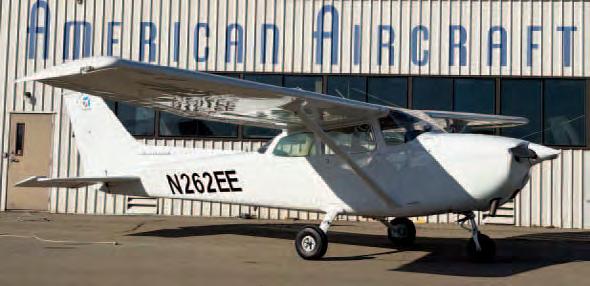


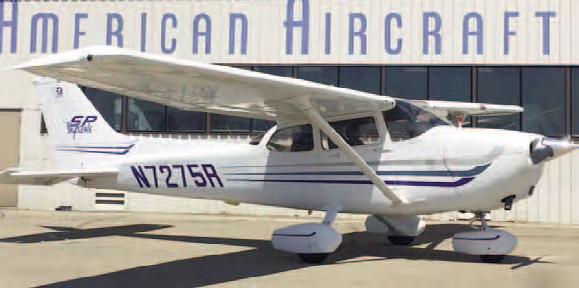


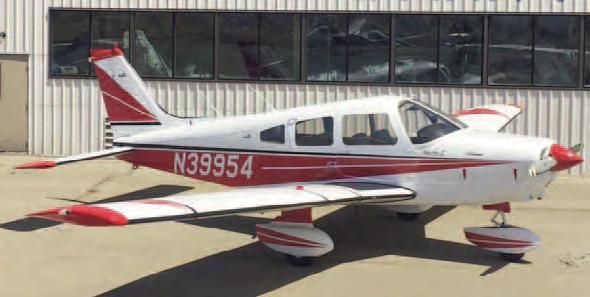
ty Summit charted the industry’s mission to net-zero emissions, innovations and the market for sustainable aviation fuel (SAF), which can reduce aviation’s lifecycle carbon emissions by as much as 80 percent. Las Vegas-area airports also made SAF available throughout 2025 NBAA-BACE.
“The 2025 NBAA-BACE fired the imagination, inspired an industry and highlighted the breakthroughs and pioneers ushering in a bright new era in business aviation,” Bolen said. “Business was conducted and connections made. This show had a tremendous vibe.”
To view highlights from the show, with photo galleries and NBAA TV videos, visit the NBAA newsroom at nbaa.org/2025/newsroom. This energy and excitement will carry forward next year, when NBAA-BACE returns to Las Vegas, Oct. 20-22, 2026. Learn more at nbaa.org/2026.






AIRCRAFT FOR SALE
American Aircraft Sales, Livermore Airport, CA, americanaircraft.net, cell (510) 783-2711, (925) 449-5151. 3/13
From Trade-ins to Aircraft Management, financing and appraisals. T.J. Aircraft Sales, Novato, CA, (415) 898-5151, tjair.com. 3/13
AirplanesUSA Aircraft Sales, San Carlos, CA, Airport, (650) 394-7610, airplanesusa.com. 1/16
Quality aircraft since 1948. Volare Air, a TECNAM dealership, (940) 800-8020, volareair.aero. 1/23
Historically significant 1950s-era aircraft for sale or trade. All in restorable condition with minimum corrosion. Inventory includes a Piasecki XHJP-1 and a Sikorsky S-55. American Helicopter Museum, West Chester, PA. Contact info@ americanhelicopter.museum for more information. 231000.TFN
1968 Nanchang CJ-6 Chinese warbird. Reliable Day/VFR, light weight. Apollo GX-65 nav/com, Digital Xpndr., intercom, Delco alternator. New seat cushions and canopy glass. Includes all support equipment, wing jacks, manu- als, spare parts. Much more! $70,000. Located N. Calif., text/cell (530) 957-9760, dennis@nickson.biz. 24900:11
1966 Piper PA30 Twin Camanche for sale near Oceanside, CA. Call for pricing. Andrew Wignot, (760) 717-0640. 241100:12
Small Manned Aerial Radar Target, Model 1. Tiny jet aircraft, long-range tank. SMART-1, Tucson, AZ, (202) 2132400, smart-1.us. 5/21
SPORT/ULTRALIGHTS
RV12i5. Total performance perfected. Easy to build, fly and own. Van’s Aircraft www.vansaircraft.com. 11/18 Bristell LSA 915 Turbo, 180 mph @18,000. Bristell Aircraft, (516) 658-1847. bristellaircraft.com. 2/24
STOL
The STOL Super Breezy with fully covered fuselage. Yakima Aerosport, (509) 453-3412, superbreezy.com. 5/23
AIRCRAFT SALES AIDS
Aviation Sales & Marketing by ABCI. Ideal for a startup or side hustle in the aviation industry. (702) 987-1679 or aviationsalestraining.com/startup. 1/21
FLIGHT INSTRUCTION
Sunshine Flyers. Flight & tailwheel instruction, rentals, mountain flying, and aerobatics., Auburn, CA, (530) 820-3442, sunshineflyersaviation@gmail.com. 3/20
Arizona Type Ratings
CE-500/CE-525 type ratings or recurrent. Insurance approved, staff examiner. arizonatyperatings.com, (602) 614-7994. 9309:TFN
Recurrent pilot training and services. L/D Aerospace, Grace Passmore, (916) 790-0501, ldaerospace.com. 1/22
Fly for fun or career. Discovery flights, pilot training, AOPA Distinguished Flight School & Cessna Pilot Center. Smith Aviation, Napa County Airport, (707) 3456526, mikesmithaviation.com. 4/22
Come fly with us! CFIs encouraged to apply. For more information, call Sue Clark/RV to the Rescue at 925-997-4778
XL Aviation - Aircraft Maintenance.
Custom-tailored programs for all aircraft. Livermore, CA, (925) 961-6135, xlaviationtailwheel.com. 8/20
Iconic Aircraft Restoration. Repairs, refurbishments, parts fabricated, consulting at reasonable rates. The Wright Experience, (540) 379-9092. 8/21
Custom aircraft & high-quality composite parts. Aviation Composites, Sandersville, GA, (937) 243-7303. 1/22
Serving the GA Community since 1981. Wisconsin Aviation, Watertown Municipal Airport, WI, (920) 261-4567, WisconsinAviation.com. 3/13
World’s largest network of FBOs with over 200 locations offering consistent, exceptional service. Signature Flight Support, signatureflight.com. 4/23
Full-service center. Vista Aviation, Whiteman Airport, Pacoima, CA, (818) 896-5224, vistaair.com 9/23
Avionics for Every Mission. All major brands. Airtronics, Calaveras County Airport, CA, airtronicsavionics.com, (209) 736-9400. 11/14
Basic installs to complete panel and glass retrofits. Pacific Coast Avionics, (800) 353-0370, PCA.aero. 7/15
Update your avionics. FAA-Certified repair station. Treasure Coast Avionics, Ft. Pierce, FL, (772) 464-3148, treasurecoastavionics.com. 2/23
AIRCRAFT PARTS
Keeping “classic” aircraft flying since 1946. Univair Aircraft Corp., Aurora, CO, (888) 433-5433, univair.com. 3/21
Iconic Aircraft Restoration for all the classics. Reasonable rates. The Wright Experience, (540) 347-1909. 2/23
SAVAGE Magneto Service since 1946. Hayward, CA, (510) 782-7081, 2/23
Wingtips with total lighting solutions, aveoengineering.com. 9/23
Aviation wood, composite or metal propellers. Sensenich, (813) 752-3711, (717) 569-0435 or sensenich.com. 4/21
OXYGEN SUPPLIES
Cannula or Mask? For aircraft service ceil- ings to FL180 & FL250. Ask “The Oxygen Lady,” info@aviationoxygen.com 4720:TFN 2/23

Fuel Cells. Repair, overhaul or new with 10-year warranty. Hartwig Aircraft Fuel Cell Repair, hartwigfuelcell.com. 2/09
Home of GAMIjectors® fuel injectors! STCs and
AVIATION SAFETY
Innovative aviation safety solutions and Parachute Recovery Systems for a variety of aircraft, including for sport, UAVs, more. AviationSafetyResources.com. 2/22
Get ahead of your daily in-flight risks with SAFETYLINQ flight risk assessment. argus.aero/safetylinq. 1/22 AIRCRAFT FINANCING
Get Top Retail Value for Your Aircraft! Sell now! Find your dream aircraft! Shop now! Become an area broker with one of the largest networks in the U.S.! Visit our USA Aircraft Brokers page on Facebook or visit usaaircraft.com. 9/23
Specializing in personal, business and charter aircraft. Best price, cover- age & customer service. Zanette Aircraft Insurance Center, (650) 593-3030, (888) 7233358. 10/06
Insurance solutions for all aviation-related services. Business Aviation Insurance, bizavins.com, (925) 825-1900. 7/20
Informed, accurate aircraft appraisals. jetvaluesjeremy.com, (636) 751-3987. 7/20
Complete Aviation Sales & Marketing Services. Use Promo Code “INFLIGHT” to save 10%. AviationBusinessConsultants.com/Lab, (702) 987-1679. 4/23
No cheap imitation watches at HME! Special pricing on ATP series multi- functional watches with Altimeter. To order or for information, (323) 464-6660 or hmewatch.com. 11/16
Aircraft Spruce & Specialty. Free 700page catalog, Corona, CA, & Peachtree City, GA, aircraftspruce.com. 10/06
Protective covers for every make and model. Bruce’s Custom Covers, Morgan Hill, CA, (800) 777-6405, (408) 738-3959, aircraftcovers.com.10/19
Apparel as unique as your journey. Discounts to members. AOPA Pilot Gear, aopapilotgear.com. 9/21
Mountain Bike, Full-size, pilot-friendly, rugged. FLATBIKE, flatbike.com. 10/18
AVIATION RESOURCES
Emergency services, group trips, consulting services. BizAvJets, Inc., Business Aviation Services, bizavjets.com, (702) 465-2027. 10/20
Wherever business takes you. Navigate It. (575) 615-2091, vatit.com. 10/21
Scheduling Software that connects to your flight department. Simple, affordable. airplanemanager.com. 9/22
Aero & Marine Tax Pros
Legally avoid sales tax on your aircraft purchase. In El Grove, CA, (916) 691-9192, aeromarinetaxpros.com. 18500:TFN
Left Seat Pilot Medical Solutions. A confidential solution for pilot medical certification. Free FAA medical consultations. Left Seat, (800) 699-4457. 1/21 Global Aircraft Group. USPAP bank values for all aircraft, aircraft management, insurance claims & certified aircraft appraisals. Mark Parry, (855) 6GBL- AIR, (413) 335-7507. 4/22
At Thirty1 Hybrid, we help aviation companies, including flight schools, manufacturers, mechanics, brokers, and more, build a cohesive website that positively impacts their bottomline. And it’s not just a website — it’s an Experience. We’ll take your prospects on a journey they’ll love (and you’ll love, too — because the final destination is a new client and more money in your pocket). It’s a win-win for everyone! Contact us today at hello@thirty1hybrid. com or by visiting thirty1hybrid.com. 24500:6
One-piece doors. Hydraulic or bifold. Schweissdoors.com,(800)746-8273. 1/15
Aviation Building Systems, custom designed hangars. R&M Steel Co., Caldwell, ID, (208) 454-1800, aviationbuildingsystem.com, (866) 454-1800 51217:TFN
HOMES/AIRPARKS
New Runway & Taxiway Homesites Available in amentity-rich community, Granbury, TX. From $179,900. Pecan Plantation, AviationHomesites. com, (833) 273-2159. 2/24
Become an Aircraft Broker — #1 Largest USA Network of Aircraft Start with USA’s proved system for listing and selling everything from high-performance single-engine airplanes, cabin class through jets, and helicopters & jet fractional shares. Includes multi-million-dollar inventory to start. Complete turnkey proved system. No experience necessary. Will train. Licensed USA Aircraft brokerage. Call (504) 723-5566 or visit Business Opportunity Section at usaaircraft.com. 4208:TFN
Free avgas 100LL and free tie-down parking in exchange for help with projects for an airport in Southern California. Email: wignot@hotmail.com. 23600:TFN
ART/VIDEOS/GIFTS
Specializing in aviation photography. horizontalrain.com. 1/15
Need a gift? Give a ride in an open cockpit biplane. WACO Air Museum, Troy, Ohio, wacoairmuseum.org, (937) 3359226. 20601:TFN
Fly By Wire Air, a one-stop site for aviators.flybywireair.com. 4/21
Aces High Aviation & Military Art. (800) 528-0887, aceshighgallery.com. 10/21
Shirts Made to Fly. Unique, original fabrics embedded with your sectional chart. Save 20% with “INFLIGHT20” code. PilotQuarters.com. 2/24
Avionics Checklists & Quick Reference guides. Available in book, card & new iPad editions. qref.com. 8/14
SEAK, Expert Witness Directory, by Bert Botta for aviation accidents and incidents. (415) 320-9811, bert@bertbotta. com, bertbotta.com. 4/22
“Ghosts,” Phil Makanna’s legendary warbird calendars are back! Visit ghosts. com, (800) 331-8231. 2/23
New Pocket guide to avoid pain & stiffness during travel by a leading pain expert. “Pain-Free Vacation/Travel,” (980) 785-8128, goptfirst@gmail.com. 2/4
PILOT POSITION WANTED
SoCal pilot desires Turbine/Jet SIC time. Comm/Instru/Multi-Eng with SIC for Gulfstream G-IV and scores of hours in the Citation V560. Many years of aircraft design/ flight test/aerospace industry experience. Willing to travel as needed (and for repositioning). Contact Paul at (562) 714-6686 or ptglessner@ aol.com. 23700:TFN
IN FLIGHT USA, the leading source of general aviation news, seeks writers and photographers to cover all aspects of aviation. Send an SASE for writer’s guidelines to: In Flight USA, P.O. Box 5402, San Mateo, CA 94402. TFN
Oakland Aviation Museum recruiting volunteers. Oakland, CA, (510) 638-7100, oaklandaviationmuseum.org. 12/23
MUSEUMS







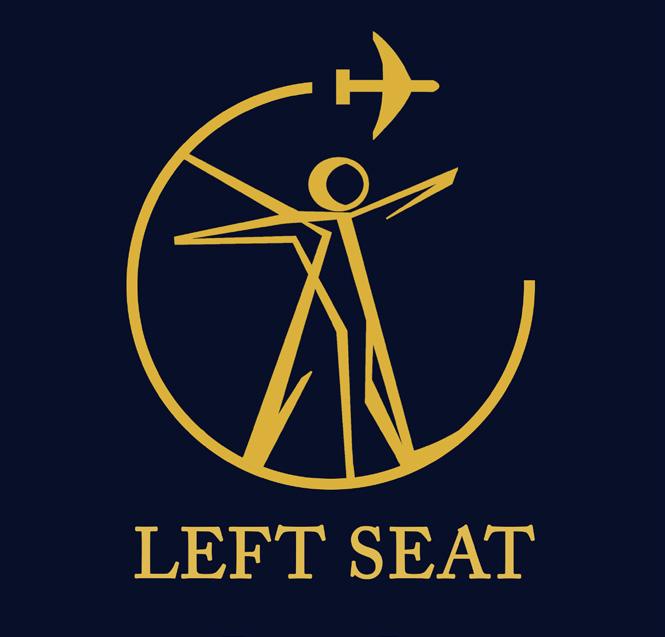
Unlike FAA Medical Examiners or other pilot groups, Pilot Medical Solutions activates our exceptional team of experts to confidentially support and resolve your FAA Medical certifications challenges.
Pilot Medical Solutions is the only service which collaborates with private physicians to produce documentation required by the FAA. Other services typically only list FAA requirements, Pilot Medical Solutions helps you comply with them.




"The professionals at Pilot Medical Solutions provide superior, pilot-focused services and help during your time of need. I would, without hesitation, recommend their services to an airman in need."
– Anthony Ison, Aviation Attorney
"Because they assist you in getting your records properly prepared and walking the information through the FAA, they can often accomplish in days what may take months for other sources, including your AME, to do."
– Erwin L. Samuelson, M.D
"I can strongly recommend Pilot Medical Solutions for consideration because they are sympathetic to pilots with medical certification problems. Pilot Medical Solutions also organizes the records which supports the FAA’s requirements."
– Bob Hoover
“They do



